-
192articlesSort byLatested
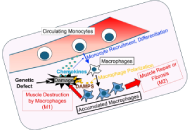 Macrophages in the pathogenesis of monogenic muscular dystrophies: inflammation, fibrosis, and therapeutic implicationsOpen AccessReviewMonogenic muscular dystrophies (MDs), such as Duchenne muscular dystrophy (DMD) and limb-girdle muscular dystrophy (LGMD), are characterized by chronic inflammation, progressive fibrosis, and impair...Jae Hyung Kim, Jea-Hyun BaekPublished: April 16, 2025 Explor Immunol. DOI: 10.37349/ei.2025.1003192
Macrophages in the pathogenesis of monogenic muscular dystrophies: inflammation, fibrosis, and therapeutic implicationsOpen AccessReviewMonogenic muscular dystrophies (MDs), such as Duchenne muscular dystrophy (DMD) and limb-girdle muscular dystrophy (LGMD), are characterized by chronic inflammation, progressive fibrosis, and impair...Jae Hyung Kim, Jea-Hyun BaekPublished: April 16, 2025 Explor Immunol. DOI: 10.37349/ei.2025.1003192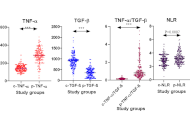 Predominant pro-inflammatory environment in mid-gestation pregnant women with history of recurrent pregnancy loss: a South Indian studyOpen AccessOriginal ArticleAim: To assess circulating levels of tumor necrosis factor-alpha (TNF-α) and transforming growth factor-beta (TGF-β) in mid-gestation pregnant women from South India, with (RPL) and without his...Rashmi Bhuwalka ... Parveen JahanPublished: April 08, 2025 Explor Immunol. DOI: 10.37349/ei.2025.1003189
Predominant pro-inflammatory environment in mid-gestation pregnant women with history of recurrent pregnancy loss: a South Indian studyOpen AccessOriginal ArticleAim: To assess circulating levels of tumor necrosis factor-alpha (TNF-α) and transforming growth factor-beta (TGF-β) in mid-gestation pregnant women from South India, with (RPL) and without his...Rashmi Bhuwalka ... Parveen JahanPublished: April 08, 2025 Explor Immunol. DOI: 10.37349/ei.2025.1003189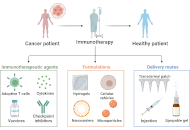 Neoantigen vaccines: advancing personalized cancer immunotherapyOpen AccessReviewNeoantigen vaccines are a promising strategy in cancer immunotherapy that leverage tumor-specific mutations to elicit targeted immune responses. Although they have considerable potential, developmen...Alaa A. A. Aljabali ... Lorca AlzoubiPublished: April 08, 2025 Explor Immunol. DOI: 10.37349/ei.2025.1003190
Neoantigen vaccines: advancing personalized cancer immunotherapyOpen AccessReviewNeoantigen vaccines are a promising strategy in cancer immunotherapy that leverage tumor-specific mutations to elicit targeted immune responses. Although they have considerable potential, developmen...Alaa A. A. Aljabali ... Lorca AlzoubiPublished: April 08, 2025 Explor Immunol. DOI: 10.37349/ei.2025.1003190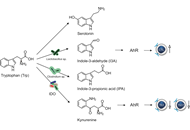 Diets for inflammatory bowel disease: impact on microbiome and immunomodulatory microbial metabolitesOpen AccessReviewDiet plays a complex role in the management of inflammatory bowel disease (IBD), significantly influencing the microbiome and metabolome. Three key metabolites implicated in IBD are short chain fatt...Hebe Mendez, Ger RijkersPublished: April 08, 2025 Explor Immunol. DOI: 10.37349/ei.2025.1003191
Diets for inflammatory bowel disease: impact on microbiome and immunomodulatory microbial metabolitesOpen AccessReviewDiet plays a complex role in the management of inflammatory bowel disease (IBD), significantly influencing the microbiome and metabolome. Three key metabolites implicated in IBD are short chain fatt...Hebe Mendez, Ger RijkersPublished: April 08, 2025 Explor Immunol. DOI: 10.37349/ei.2025.1003191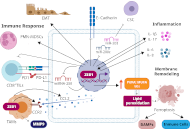 Role of ZEB1 in immune response, inflammation and membrane remodeling during neoplasiaOpen AccessReviewImmune response, inflammation, and lipid metabolism have important effects on cancer development and progression. Several proteins in tumoral cells and/or tumor microenvironment are involved in any ...Alicia Maria Reveles-Espinoza ... Alba Adriana Vallejo-CardonaPublished: March 20, 2025 Explor Immunol. DOI: 10.37349/ei.2025.1003187
Role of ZEB1 in immune response, inflammation and membrane remodeling during neoplasiaOpen AccessReviewImmune response, inflammation, and lipid metabolism have important effects on cancer development and progression. Several proteins in tumoral cells and/or tumor microenvironment are involved in any ...Alicia Maria Reveles-Espinoza ... Alba Adriana Vallejo-CardonaPublished: March 20, 2025 Explor Immunol. DOI: 10.37349/ei.2025.1003187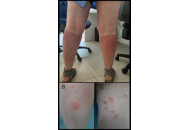 Erythema multiforme: distinguishing hypersensitivity reactions, drug allergy, or herpes simplex infectionOpen AccessCase ReportCutaneous reactions present a diagnostic challenge, mainly when multiple factors, such as infections, medications, and environmental triggers, contribute to the clinical picture. Erythema multiforme...Vesna Vukičević LazarevićPublished: March 20, 2025 Explor Immunol. DOI: 10.37349/ei.2025.1003188
Erythema multiforme: distinguishing hypersensitivity reactions, drug allergy, or herpes simplex infectionOpen AccessCase ReportCutaneous reactions present a diagnostic challenge, mainly when multiple factors, such as infections, medications, and environmental triggers, contribute to the clinical picture. Erythema multiforme...Vesna Vukičević LazarevićPublished: March 20, 2025 Explor Immunol. DOI: 10.37349/ei.2025.1003188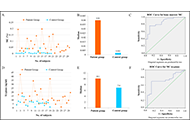 Bone marrow mast cells and mast cell tryptase in plasma cell disordersOpen AccessOriginal ArticleAim: Plasma cell disorders (PCD), a group of B-cell neoplasms, have undefined etiology. Mast cells (MC) have been found to promote the proliferation and differentiation of B cells in several B ce...Raveena Yadav ... Yashwant KumarPublished: March 12, 2025 Explor Immunol. DOI: 10.37349/ei.2025.1003186
Bone marrow mast cells and mast cell tryptase in plasma cell disordersOpen AccessOriginal ArticleAim: Plasma cell disorders (PCD), a group of B-cell neoplasms, have undefined etiology. Mast cells (MC) have been found to promote the proliferation and differentiation of B cells in several B ce...Raveena Yadav ... Yashwant KumarPublished: March 12, 2025 Explor Immunol. DOI: 10.37349/ei.2025.1003186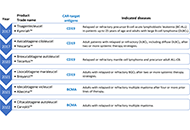 A new therapeutic pathway in autoimmune diseases: chimeric antigen receptor T cells (CAR-T) targeting specific cell subtypes or antigen-specific B lymphocytes—a brief reviewOpen AccessReviewIn hematological malignancies, autologous immunotherapy with T lymphocytes expressing a chimeric antigen receptor (CAR-T) has been successfully applied. CAR enhances the immuno-cellular effector sys...María Fernanda Segovia ... Gerson D. KeppekePublished: March 04, 2025 Explor Immunol. DOI: 10.37349/ei.2025.1003185
A new therapeutic pathway in autoimmune diseases: chimeric antigen receptor T cells (CAR-T) targeting specific cell subtypes or antigen-specific B lymphocytes—a brief reviewOpen AccessReviewIn hematological malignancies, autologous immunotherapy with T lymphocytes expressing a chimeric antigen receptor (CAR-T) has been successfully applied. CAR enhances the immuno-cellular effector sys...María Fernanda Segovia ... Gerson D. KeppekePublished: March 04, 2025 Explor Immunol. DOI: 10.37349/ei.2025.1003185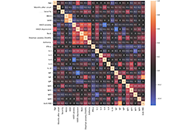 Cytokine profiles and neurological manifestations in post-COVID syndromeOpen AccessOriginal ArticleAim: The objectives of our study were to evaluate a range of circulating biomarkers in COVID-19-related long-term neurological dysfunction. Methods: The study involved 30 patients with post...Yulia Desheva ... Alexander SuvorovPublished: February 24, 2025 Explor Immunol. DOI: 10.37349/ei.2025.1003184
Cytokine profiles and neurological manifestations in post-COVID syndromeOpen AccessOriginal ArticleAim: The objectives of our study were to evaluate a range of circulating biomarkers in COVID-19-related long-term neurological dysfunction. Methods: The study involved 30 patients with post...Yulia Desheva ... Alexander SuvorovPublished: February 24, 2025 Explor Immunol. DOI: 10.37349/ei.2025.1003184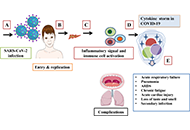 Microbiome and mycobiome cross-talk from an immunobiotic perspective in COVID-19 and post-acute COVID-19 syndromeOpen AccessReviewCoronavirus disease 2019 (COVID-19) infected individuals showed either mild symptoms or is paucisymptomatic, with severe impact on human health, revealing heightened risk and direct effects on healt...Sunny Kumar ... Sriram SeshadriPublished: February 11, 2025 Explor Immunol. DOI: 10.37349/ei.2025.1003182
Microbiome and mycobiome cross-talk from an immunobiotic perspective in COVID-19 and post-acute COVID-19 syndromeOpen AccessReviewCoronavirus disease 2019 (COVID-19) infected individuals showed either mild symptoms or is paucisymptomatic, with severe impact on human health, revealing heightened risk and direct effects on healt...Sunny Kumar ... Sriram SeshadriPublished: February 11, 2025 Explor Immunol. DOI: 10.37349/ei.2025.1003182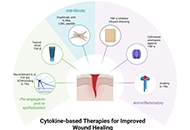 The role of cytokines in wound healing: from mechanistic insights to therapeutic applicationsOpen AccessReviewWound healing is an area of growing importance in the healthcare field, especially chronic wounds associated with comorbidities like diabetes mellitus (DM), hypoxic stress, obesity, and malnutrition...Rachel Si-Yin Wong ... Dinesh Kumar SrinivasanPublished: February 11, 2025 Explor Immunol. DOI: 10.37349/ei.2025.1003183
The role of cytokines in wound healing: from mechanistic insights to therapeutic applicationsOpen AccessReviewWound healing is an area of growing importance in the healthcare field, especially chronic wounds associated with comorbidities like diabetes mellitus (DM), hypoxic stress, obesity, and malnutrition...Rachel Si-Yin Wong ... Dinesh Kumar SrinivasanPublished: February 11, 2025 Explor Immunol. DOI: 10.37349/ei.2025.1003183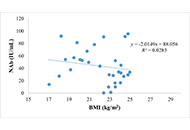 Factors associated with the formation of neutralizing antibodies post-vaccination: a lesson from COVID-19 vaccinationOpen AccessOriginal ArticleAim: This study aims to identify the factors affecting the formation of neutralizing antibodies (NAbs) in healthy adults four weeks post-COVID-19 vaccination. Methods: A cross-sectional stu...Hana Ratnawati ... Steven FelimPublished: January 22, 2025 Explor Immunol. DOI: 10.37349/ei.2025.1003180
Factors associated with the formation of neutralizing antibodies post-vaccination: a lesson from COVID-19 vaccinationOpen AccessOriginal ArticleAim: This study aims to identify the factors affecting the formation of neutralizing antibodies (NAbs) in healthy adults four weeks post-COVID-19 vaccination. Methods: A cross-sectional stu...Hana Ratnawati ... Steven FelimPublished: January 22, 2025 Explor Immunol. DOI: 10.37349/ei.2025.1003180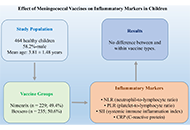 The effect of meningococcal vaccines on new generation of systemic inflammatory markers in childrenOpen AccessOriginal ArticleAim: Immunization with meningococcal vaccine (MV) is the most effective measure to control and prevent the transmission of meningococcal infections. In this study, in order to support the appropr...Omer Okuyan ... Hafize UzunPublished: January 23, 2025 Explor Immunol. DOI: 10.37349/ei.2025.1003181
The effect of meningococcal vaccines on new generation of systemic inflammatory markers in childrenOpen AccessOriginal ArticleAim: Immunization with meningococcal vaccine (MV) is the most effective measure to control and prevent the transmission of meningococcal infections. In this study, in order to support the appropr...Omer Okuyan ... Hafize UzunPublished: January 23, 2025 Explor Immunol. DOI: 10.37349/ei.2025.1003181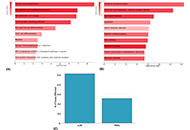 Characterizing immune biomarkers and effector CD8+ T-cell exhaustion in pancreatic adenocarcinoma via single-cell RNA sequencing profilingOpen AccessOriginal ArticleAim: Pancreatic ductal adenocarcinoma (PDAC) is a leading cause of cancer-related mortality and is characterized by T-cell exhaustion, particularly in effector CD8+ T-cells. This exhaustion, driv...Rawaa AlChalabi ... Ahmed AbdulJabbar SuleimanPublished: January 21, 2025 Explor Immunol. DOI: 10.37349/ei.2025.1003179
Characterizing immune biomarkers and effector CD8+ T-cell exhaustion in pancreatic adenocarcinoma via single-cell RNA sequencing profilingOpen AccessOriginal ArticleAim: Pancreatic ductal adenocarcinoma (PDAC) is a leading cause of cancer-related mortality and is characterized by T-cell exhaustion, particularly in effector CD8+ T-cells. This exhaustion, driv...Rawaa AlChalabi ... Ahmed AbdulJabbar SuleimanPublished: January 21, 2025 Explor Immunol. DOI: 10.37349/ei.2025.1003179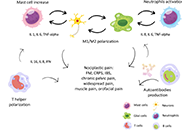 The putative role of immune-inflammatory mechanisms in nociplastic pain pathways: a narrative reviewOpen AccessReviewNociplastic pain is the fourth category of pain defined in recent years. It is a pain arising from altered nociception, despite the lack of clear evidence of actual or threatened tissue damage that ...Mariateresa Giglio ... Filomena PuntilloPublished: January 13, 2025 Explor Immunol. DOI: 10.37349/ei.2025.1003178
The putative role of immune-inflammatory mechanisms in nociplastic pain pathways: a narrative reviewOpen AccessReviewNociplastic pain is the fourth category of pain defined in recent years. It is a pain arising from altered nociception, despite the lack of clear evidence of actual or threatened tissue damage that ...Mariateresa Giglio ... Filomena PuntilloPublished: January 13, 2025 Explor Immunol. DOI: 10.37349/ei.2025.1003178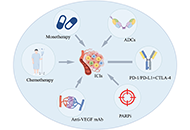 Research progress of immune checkpoint inhibitors in ovarian cancerOpen AccessReviewOvarian cancer is the deadliest malignant tumor in the female reproductive system. Despite advancements in standard treatments such as tumor debulking surgery and platinum-based chemotherapy, the ov...Lingli Zhao ... Gaoli NiuPublished: December 18, 2024 Explor Immunol. DOI: 10.37349/ei.2024.00177
Research progress of immune checkpoint inhibitors in ovarian cancerOpen AccessReviewOvarian cancer is the deadliest malignant tumor in the female reproductive system. Despite advancements in standard treatments such as tumor debulking surgery and platinum-based chemotherapy, the ov...Lingli Zhao ... Gaoli NiuPublished: December 18, 2024 Explor Immunol. DOI: 10.37349/ei.2024.00177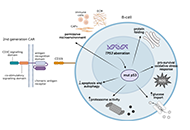 Impact of TP53 mutations on the efficacy of CAR-T cell therapy in cancerOpen AccessReviewThe efficacy of chimeric antigen receptor (CAR)-T therapy may not match initial expectations due to the influence of multiple circumstances, some of which cannot be predicted. CAR-T treatment groups...Regina Mirgayazova ... Emil BulatovPublished: December 15, 2024 Explor Immunol. DOI: 10.37349/ei.2024.00176
Impact of TP53 mutations on the efficacy of CAR-T cell therapy in cancerOpen AccessReviewThe efficacy of chimeric antigen receptor (CAR)-T therapy may not match initial expectations due to the influence of multiple circumstances, some of which cannot be predicted. CAR-T treatment groups...Regina Mirgayazova ... Emil BulatovPublished: December 15, 2024 Explor Immunol. DOI: 10.37349/ei.2024.00176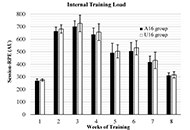 Influence of puberty stage in immune-inflammatory parameters in well-trained adolescent soccer-players, following 8-weeks of pre-seasonal preparation trainingOpen AccessOriginal ArticleAim: The immune system can experience temporary suppression following acute or prolonged strenuous exercise, potentially increasing susceptibility to infections. Young athletes, who must balance ...Marios Hadjicharalambous ... Nikolaos ZarasPublished: December 10, 2024 Explor Immunol. DOI: 10.37349/ei.2024.00175
Influence of puberty stage in immune-inflammatory parameters in well-trained adolescent soccer-players, following 8-weeks of pre-seasonal preparation trainingOpen AccessOriginal ArticleAim: The immune system can experience temporary suppression following acute or prolonged strenuous exercise, potentially increasing susceptibility to infections. Young athletes, who must balance ...Marios Hadjicharalambous ... Nikolaos ZarasPublished: December 10, 2024 Explor Immunol. DOI: 10.37349/ei.2024.00175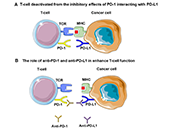 Dissecting the link between PD-1/PD-L1-based immunotherapy and cancer pain: mechanisms, research implications, and artificial intelligence perspectivesOpen AccessReviewCancer-related pain represents one of the most common complaints of cancer patients especially for those with advanced-stage of disease and/or bone metastases. More effective therapeutic strategies ...Marco Cascella ... The TRIAL GroupPublished: December 04, 2024 Explor Immunol. DOI: 10.37349/ei.2024.00174
Dissecting the link between PD-1/PD-L1-based immunotherapy and cancer pain: mechanisms, research implications, and artificial intelligence perspectivesOpen AccessReviewCancer-related pain represents one of the most common complaints of cancer patients especially for those with advanced-stage of disease and/or bone metastases. More effective therapeutic strategies ...Marco Cascella ... The TRIAL GroupPublished: December 04, 2024 Explor Immunol. DOI: 10.37349/ei.2024.00174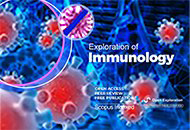 Association of genetic variations of interleukin-6 polymorphism (rs1800795) with susceptibility to Hashimoto’s thyroiditis in West Algerian populationOpen AccessOriginal ArticleAim: Hashimoto’s thyroiditis is a polygenic auto-immune disease with a complex etiopathogenesis. It is more common in females. An imbalance between pro-inflammatory and anti-inflammatory cytoki...Nawal Labiad ... Nardjess OuikhlefPublished: December 03, 2024 Explor Immunol. DOI: 10.37349/ei.2024.00173
Association of genetic variations of interleukin-6 polymorphism (rs1800795) with susceptibility to Hashimoto’s thyroiditis in West Algerian populationOpen AccessOriginal ArticleAim: Hashimoto’s thyroiditis is a polygenic auto-immune disease with a complex etiopathogenesis. It is more common in females. An imbalance between pro-inflammatory and anti-inflammatory cytoki...Nawal Labiad ... Nardjess OuikhlefPublished: December 03, 2024 Explor Immunol. DOI: 10.37349/ei.2024.00173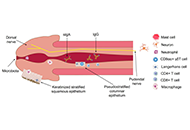 Current challenges in the modern male immune systemOpen AccessReviewThe tripartite network, including the nervous, immune, and endocrine systems, plays a significant role in regulatory and effector processes in the male body. On the one hand, males perform their rep...Vladimir Klimov, Andrew KlimovPublished: November 28, 2024 Explor Immunol. DOI: 10.37349/ei.2024.00172
Current challenges in the modern male immune systemOpen AccessReviewThe tripartite network, including the nervous, immune, and endocrine systems, plays a significant role in regulatory and effector processes in the male body. On the one hand, males perform their rep...Vladimir Klimov, Andrew KlimovPublished: November 28, 2024 Explor Immunol. DOI: 10.37349/ei.2024.00172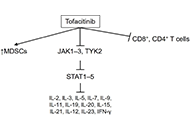 The growing potential of tofacitinib in immune checkpoint inhibitor-induced colitis: identifying remaining puzzle piecesOpen AccessReviewImmunotherapy, a primary anti-neoplastic treatment, exploits the patient’s immune system to kill neoplastic cells by modulating immune checkpoints such as cytotoxic T-lymphocyte antigen 4 and prog...Raffaele Pellegrino ... Antonietta Gerarda GravinaPublished: November 21, 2024 Explor Immunol. DOI: 10.37349/ei.2024.00171
The growing potential of tofacitinib in immune checkpoint inhibitor-induced colitis: identifying remaining puzzle piecesOpen AccessReviewImmunotherapy, a primary anti-neoplastic treatment, exploits the patient’s immune system to kill neoplastic cells by modulating immune checkpoints such as cytotoxic T-lymphocyte antigen 4 and prog...Raffaele Pellegrino ... Antonietta Gerarda GravinaPublished: November 21, 2024 Explor Immunol. DOI: 10.37349/ei.2024.00171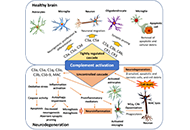 Plant derived bioactive compounds for the treatment of neurodegeneration and neuroimmune disorders associated with the complement systemOpen AccessReviewThe complement system is a key component of the innate immune system that mediates the clearance of pathogens, apoptotic cells, and cellular debris. However, the complement system also has diverse r...Jeyaparthasarathy Narayanaperumal, Ganesh GopalPublished: November 15, 2024 Explor Immunol. DOI: 10.37349/ei.2024.00170
Plant derived bioactive compounds for the treatment of neurodegeneration and neuroimmune disorders associated with the complement systemOpen AccessReviewThe complement system is a key component of the innate immune system that mediates the clearance of pathogens, apoptotic cells, and cellular debris. However, the complement system also has diverse r...Jeyaparthasarathy Narayanaperumal, Ganesh GopalPublished: November 15, 2024 Explor Immunol. DOI: 10.37349/ei.2024.00170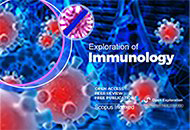 Correction: The role of interleukin-24 in atopic dermatitisOpen AccessCorrectionEditorial OfficePublished: November 07, 2024 Explor Immunol. DOI: 10.37349/ei.2024.00169
Correction: The role of interleukin-24 in atopic dermatitisOpen AccessCorrectionEditorial OfficePublished: November 07, 2024 Explor Immunol. DOI: 10.37349/ei.2024.00169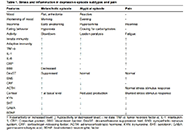 The role of immunity in comorbid pain and depressionOpen AccessReviewThe narrative review aims to shed light on the influence of inflammation in the comorbid chronic pain and major depressive disorder (MDD). This connection is known to be multifactorial, with a dynam...Antonella Ciaramella, Giancarlo CarliPublished: November 04, 2024 Explor Immunol. DOI: 10.37349/ei.2024.00168
The role of immunity in comorbid pain and depressionOpen AccessReviewThe narrative review aims to shed light on the influence of inflammation in the comorbid chronic pain and major depressive disorder (MDD). This connection is known to be multifactorial, with a dynam...Antonella Ciaramella, Giancarlo CarliPublished: November 04, 2024 Explor Immunol. DOI: 10.37349/ei.2024.00168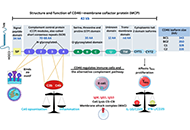 Understanding measles virus: from isolation to immunological cellular mechanisms and immunisation 1954–2024Open AccessReviewMeasles virus (Morbillivirus abbreviated as MV, but more recently MeV) is the causal agent of measles disease, thought to have existed at least 4,000 years ago, affecting predominantly infants, but ...Brent Brown ... Ingo FrickePublished: November 01, 2024 Explor Immunol. DOI: 10.37349/ei.2024.00167
Understanding measles virus: from isolation to immunological cellular mechanisms and immunisation 1954–2024Open AccessReviewMeasles virus (Morbillivirus abbreviated as MV, but more recently MeV) is the causal agent of measles disease, thought to have existed at least 4,000 years ago, affecting predominantly infants, but ...Brent Brown ... Ingo FrickePublished: November 01, 2024 Explor Immunol. DOI: 10.37349/ei.2024.00167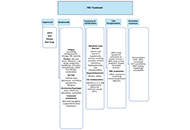 Primary biliary cholangitis, a rising health burdenOpen AccessReviewPrimary biliary cholangitis (PBC) is a rare immune-mediated disease, commonly affecting women in their 40s, and ultimately progressing to liver failure. The incidence and prevalence of the disease a...Mohamed Bassyouny Aboueleinin Elnaggar ... James Lorenzen BoyerPublished: October 29, 2024 Explor Immunol. DOI: 10.37349/ei.2024.00165
Primary biliary cholangitis, a rising health burdenOpen AccessReviewPrimary biliary cholangitis (PBC) is a rare immune-mediated disease, commonly affecting women in their 40s, and ultimately progressing to liver failure. The incidence and prevalence of the disease a...Mohamed Bassyouny Aboueleinin Elnaggar ... James Lorenzen BoyerPublished: October 29, 2024 Explor Immunol. DOI: 10.37349/ei.2024.00165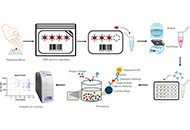 Durability of SARS-CoV-2 IgG response: a cross-sectional study in vaccinated healthcare workers using dried blood spot and multi-antigen profilingOpen AccessOriginal ArticleAim: Assessing severe acute respiratory syndrome coronavirus 2 (SARS-CoV-2) immunoglobulin G (IgG) antibodies among healthcare workers (HCWs) is crucial in understanding the durability of humoral...Imam Nurjaya ... Moh. Anfasa Giffari MakkarakaPublished: October 29, 2024 Explor Immunol. DOI: 10.37349/ei.2024.00166
Durability of SARS-CoV-2 IgG response: a cross-sectional study in vaccinated healthcare workers using dried blood spot and multi-antigen profilingOpen AccessOriginal ArticleAim: Assessing severe acute respiratory syndrome coronavirus 2 (SARS-CoV-2) immunoglobulin G (IgG) antibodies among healthcare workers (HCWs) is crucial in understanding the durability of humoral...Imam Nurjaya ... Moh. Anfasa Giffari MakkarakaPublished: October 29, 2024 Explor Immunol. DOI: 10.37349/ei.2024.00166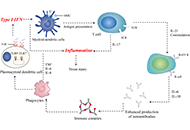 Epigenetic regulation of FOXP3 gene expression in relation to impaired function of regulatory T cells in systemic lupus erythematosusOpen AccessReviewThe impaired function of regulatory T (Treg) cells and the imbalance of Treg/Th17 cells play a central role in developing autoimmune diseases such as systemic lupus erythematosus (SLE). Treg cells a...Parnian Fakour ... Ghasem SolgiPublished: October 21, 2024 Explor Immunol. DOI: 10.37349/ei.2024.00164
Epigenetic regulation of FOXP3 gene expression in relation to impaired function of regulatory T cells in systemic lupus erythematosusOpen AccessReviewThe impaired function of regulatory T (Treg) cells and the imbalance of Treg/Th17 cells play a central role in developing autoimmune diseases such as systemic lupus erythematosus (SLE). Treg cells a...Parnian Fakour ... Ghasem SolgiPublished: October 21, 2024 Explor Immunol. DOI: 10.37349/ei.2024.00164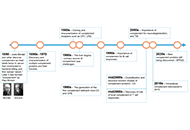 The future of complement therapeuticsOpen AccessReviewComplement is both evolutionary and scientifically old. It predates the adaptive immunity by some 600 million years and was first described in 1905 by Jules Bordet and Paul Ehrlich. For the most of ...Martin Kolev ... Pascal DeschateletsPublished: October 18, 2024 Explor Immunol. DOI: 10.37349/ei.2024.00161
The future of complement therapeuticsOpen AccessReviewComplement is both evolutionary and scientifically old. It predates the adaptive immunity by some 600 million years and was first described in 1905 by Jules Bordet and Paul Ehrlich. For the most of ...Martin Kolev ... Pascal DeschateletsPublished: October 18, 2024 Explor Immunol. DOI: 10.37349/ei.2024.00161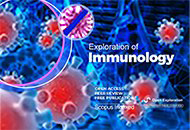 Long-chain noncoding RNA NEAT1 and autoimmune diseasesOpen AccessMini ReviewAutoimmune diseases result from the immune system’s response to autoantigen components, leading to damage to one’s own tissues and organs. The correlation between long noncoding RNAs (lncRNAs) a...Cheng Bao ... Hong-Wei ChenPublished: October 18, 2024 Explor Immunol. DOI: 10.37349/ei.2024.00162
Long-chain noncoding RNA NEAT1 and autoimmune diseasesOpen AccessMini ReviewAutoimmune diseases result from the immune system’s response to autoantigen components, leading to damage to one’s own tissues and organs. The correlation between long noncoding RNAs (lncRNAs) a...Cheng Bao ... Hong-Wei ChenPublished: October 18, 2024 Explor Immunol. DOI: 10.37349/ei.2024.00162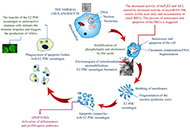 Mechanism of formation and significance of antimitochondrial autoantibodies in the pathogenesis of primary biliary cholangitisOpen AccessReviewPrimary biliary cholangitis (PBC) is a chronic cholestatic progressive liver disease associated with cholangiopathies. The detection of antimitochondrial autoantibodies (AMAs) plays an important rol...Vasiliy Ivanovich Reshetnyak, Igor Veniaminovich MaevPublished: October 18, 2024 Explor Immunol. DOI: 10.37349/ei.2024.00163
Mechanism of formation and significance of antimitochondrial autoantibodies in the pathogenesis of primary biliary cholangitisOpen AccessReviewPrimary biliary cholangitis (PBC) is a chronic cholestatic progressive liver disease associated with cholangiopathies. The detection of antimitochondrial autoantibodies (AMAs) plays an important rol...Vasiliy Ivanovich Reshetnyak, Igor Veniaminovich MaevPublished: October 18, 2024 Explor Immunol. DOI: 10.37349/ei.2024.00163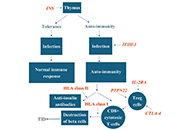 A review of the genetics of type I diabetesOpen AccessReviewType I diabetes susceptibility is caused by both environmental and genetic factors, the latter comprising approximately half of the total risk as evidenced by the fact that identical twins have appr...Brian D. TaitPublished: September 25, 2024 Explor Immunol. DOI: 10.37349/ei.2024.00160
A review of the genetics of type I diabetesOpen AccessReviewType I diabetes susceptibility is caused by both environmental and genetic factors, the latter comprising approximately half of the total risk as evidenced by the fact that identical twins have appr...Brian D. TaitPublished: September 25, 2024 Explor Immunol. DOI: 10.37349/ei.2024.00160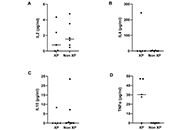 Proinflammatory cytokines in xeroderma pigmentosum (XP) and non-XP cancer patients—a pilot studyOpen AccessOriginal ArticleAim: Testing the feasibility of the determination to what extent the inability to repair DNA lesions in xeroderma pigmentosum (XP) patients, contributes to the alteration of immune responses, in ...Kalthoum Abid ... Hamouda BoussenPublished: September 04, 2024 Explor Immunol. DOI: 10.37349/ei.2024.00159
Proinflammatory cytokines in xeroderma pigmentosum (XP) and non-XP cancer patients—a pilot studyOpen AccessOriginal ArticleAim: Testing the feasibility of the determination to what extent the inability to repair DNA lesions in xeroderma pigmentosum (XP) patients, contributes to the alteration of immune responses, in ...Kalthoum Abid ... Hamouda BoussenPublished: September 04, 2024 Explor Immunol. DOI: 10.37349/ei.2024.00159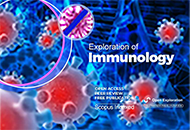 Exploration of Immunology: immunology through the agesOpen AccessEditorialCalogero CarusoPublished: September 01, 2024 Explor Immunol. DOI: 10.37349/ei.2024.00158
Exploration of Immunology: immunology through the agesOpen AccessEditorialCalogero CarusoPublished: September 01, 2024 Explor Immunol. DOI: 10.37349/ei.2024.00158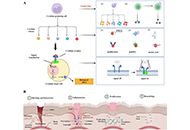 Advances in rationally engineered cytokines for precision therapy in diabetic wound healingOpen AccessReviewDiabetic wound healing presents a unique and complex challenge due to the impaired cellular and molecular functions associated with diabetes. Chronic wounds in diabetic patients are characterized by...Xinxin Zhang ... Hong-Hui WangPublished: August 28, 2024 Explor Immunol. DOI: 10.37349/ei.2024.00157
Advances in rationally engineered cytokines for precision therapy in diabetic wound healingOpen AccessReviewDiabetic wound healing presents a unique and complex challenge due to the impaired cellular and molecular functions associated with diabetes. Chronic wounds in diabetic patients are characterized by...Xinxin Zhang ... Hong-Hui WangPublished: August 28, 2024 Explor Immunol. DOI: 10.37349/ei.2024.00157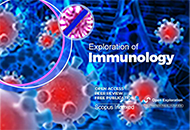 Evolving role of immunology in chronic pain medicine: tissue necrosis factor and interleukin modulatory treatmentsOpen AccessMini ReviewOur immune system acts to protect us in times of stress and traumatic injury. As part of the immune response, the body produces various cytokines, which mediate or modulate immune functions. Such cy...Rucha A. Kelkar ... Giustino VarrassiPublished: August 28, 2024 Explor Immunol. DOI: 10.37349/ei.2024.00156
Evolving role of immunology in chronic pain medicine: tissue necrosis factor and interleukin modulatory treatmentsOpen AccessMini ReviewOur immune system acts to protect us in times of stress and traumatic injury. As part of the immune response, the body produces various cytokines, which mediate or modulate immune functions. Such cy...Rucha A. Kelkar ... Giustino VarrassiPublished: August 28, 2024 Explor Immunol. DOI: 10.37349/ei.2024.00156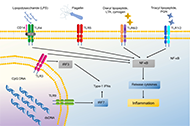 Critical role of keratinocytes in cutaneous immune responsesOpen AccessReviewKeratinocytes play an integral role in the human epidermis, serving as a barrier between the internal and external environment. They are immune-competent cells involved in both innate and adaptive c...Rakesh Kumar Gupta ... Dhananjay ShuklaPublished: August 27, 2024 Explor Immunol. DOI: 10.37349/ei.2024.00155
Critical role of keratinocytes in cutaneous immune responsesOpen AccessReviewKeratinocytes play an integral role in the human epidermis, serving as a barrier between the internal and external environment. They are immune-competent cells involved in both innate and adaptive c...Rakesh Kumar Gupta ... Dhananjay ShuklaPublished: August 27, 2024 Explor Immunol. DOI: 10.37349/ei.2024.00155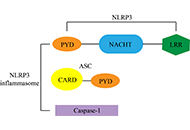 Research progress on NLRP3 inflammasomes in male reproductive immunityOpen AccessReviewThe male reproductive immune system plays a pivotal role in safeguarding sperm from immune attacks and preventing the incursion of foreign pathogens. Nucleotide-binding and oligomerization domain-li...Xue Zhang ... Donghui HuangPublished: August 22, 2024 Explor Immunol. DOI: 10.37349/ei.2024.00154
Research progress on NLRP3 inflammasomes in male reproductive immunityOpen AccessReviewThe male reproductive immune system plays a pivotal role in safeguarding sperm from immune attacks and preventing the incursion of foreign pathogens. Nucleotide-binding and oligomerization domain-li...Xue Zhang ... Donghui HuangPublished: August 22, 2024 Explor Immunol. DOI: 10.37349/ei.2024.00154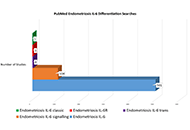 IL-6 signaling pathway differentiation for endometriosis and inflammatory diseasesOpen AccessReviewInterleukin-6 (IL-6) plays a critical role in the pathogenesis of various chronic inflammatory diseases, tracked across numerous fields of research. Despite this, a crucial aspect often overlooked i...Ryan D. CastlePublished: August 20, 2024 Explor Immunol. DOI: 10.37349/ei.2024.00153
IL-6 signaling pathway differentiation for endometriosis and inflammatory diseasesOpen AccessReviewInterleukin-6 (IL-6) plays a critical role in the pathogenesis of various chronic inflammatory diseases, tracked across numerous fields of research. Despite this, a crucial aspect often overlooked i...Ryan D. CastlePublished: August 20, 2024 Explor Immunol. DOI: 10.37349/ei.2024.00153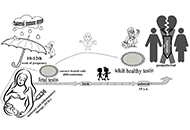 Healthy functioning mammal male reproductive system is determined during prenatal development: long-term consequences of maternal immune activationOpen AccessReviewThe reproductive axis of male mammals implies a coordinated interaction of its three components: a population of gonadotropin-releasing hormone (GnRH)—producing neurons of the hypothalamus, gonado...Marina IzvolskayaPublished: August 07, 2024 Explor Immunol. DOI: 10.37349/ei.2024.00152
Healthy functioning mammal male reproductive system is determined during prenatal development: long-term consequences of maternal immune activationOpen AccessReviewThe reproductive axis of male mammals implies a coordinated interaction of its three components: a population of gonadotropin-releasing hormone (GnRH)—producing neurons of the hypothalamus, gonado...Marina IzvolskayaPublished: August 07, 2024 Explor Immunol. DOI: 10.37349/ei.2024.00152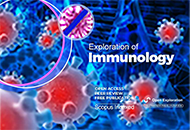 Testicular inflammation in male reproductive systemOpen AccessReviewThe control of the immune system, neuroendocrine system, and energy metabolism is essential for the physiological process of male reproduction. The hypothalamic-pituitary-testicular (HPT) axis regul...Prity Yadav, Pratap Chand MaliPublished: August 05, 2024 Explor Immunol. DOI: 10.37349/ei.2024.00151
Testicular inflammation in male reproductive systemOpen AccessReviewThe control of the immune system, neuroendocrine system, and energy metabolism is essential for the physiological process of male reproduction. The hypothalamic-pituitary-testicular (HPT) axis regul...Prity Yadav, Pratap Chand MaliPublished: August 05, 2024 Explor Immunol. DOI: 10.37349/ei.2024.00151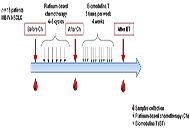 Assessment of non-classical lymphocyte populations in patients with advanced lung cancer treated with Biomodulina T following platinum-based chemotherapyOpen AccessOriginal ArticleAim: Currently, malignant diseases represent a health issue worldwide. Among these, lung cancer is of growing importance, due to its high incidence and mortality. Chemotherapy, one of the most fr...Gisela María Suárez ... Danay SaavedraPublished: August 05, 2024 Explor Immunol. DOI: 10.37349/ei.2024.00150
Assessment of non-classical lymphocyte populations in patients with advanced lung cancer treated with Biomodulina T following platinum-based chemotherapyOpen AccessOriginal ArticleAim: Currently, malignant diseases represent a health issue worldwide. Among these, lung cancer is of growing importance, due to its high incidence and mortality. Chemotherapy, one of the most fr...Gisela María Suárez ... Danay SaavedraPublished: August 05, 2024 Explor Immunol. DOI: 10.37349/ei.2024.00150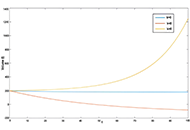 Exploring the impact of immune response on tumor heterogeneity through mathematical modelingOpen AccessOriginal ArticleAim: This article presents an investigation into various mathematical models for cell population growth, including tumor cells, and their dynamics. Methods: We classify the models into five...Diksha Gautam ... Deepshikha DixitPublished: July 18, 2024 Explor Immunol. DOI: 10.37349/ei.2024.00149
Exploring the impact of immune response on tumor heterogeneity through mathematical modelingOpen AccessOriginal ArticleAim: This article presents an investigation into various mathematical models for cell population growth, including tumor cells, and their dynamics. Methods: We classify the models into five...Diksha Gautam ... Deepshikha DixitPublished: July 18, 2024 Explor Immunol. DOI: 10.37349/ei.2024.00149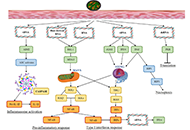 Herpes simplex virus-mediated skin infections: cytokines and its interplayOpen AccessReviewThe skin, as the first physical barrier for invading pathogens, also serves as an immunologically active organ. Breaching the skin barrier is thus essential for pathogens to enter the body. The skin...Aparna Mukhopadhyay ... Debprasad ChattopadhyayPublished: June 30, 2024 Explor Immunol. DOI: 10.37349/ei.2024.00148
Herpes simplex virus-mediated skin infections: cytokines and its interplayOpen AccessReviewThe skin, as the first physical barrier for invading pathogens, also serves as an immunologically active organ. Breaching the skin barrier is thus essential for pathogens to enter the body. The skin...Aparna Mukhopadhyay ... Debprasad ChattopadhyayPublished: June 30, 2024 Explor Immunol. DOI: 10.37349/ei.2024.00148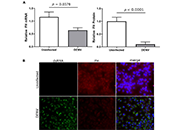 Dengue virus infection induces complement factor H but protein remains cell-associated, with changes intracellularly and in cell surface bindingOpen AccessOriginal ArticleAim: Severe dengue is correlated with a decrease in the circulating complement regulator, factor H (FH) and prior work has shown that dengue virus (DENV) infection induces FH mRNA but not FH prot...Joshua G. Dubowsky ... Jillian M. CarrPublished: June 24, 2024 Explor Immunol. DOI: 10.37349/ei.2024.00147
Dengue virus infection induces complement factor H but protein remains cell-associated, with changes intracellularly and in cell surface bindingOpen AccessOriginal ArticleAim: Severe dengue is correlated with a decrease in the circulating complement regulator, factor H (FH) and prior work has shown that dengue virus (DENV) infection induces FH mRNA but not FH prot...Joshua G. Dubowsky ... Jillian M. CarrPublished: June 24, 2024 Explor Immunol. DOI: 10.37349/ei.2024.00147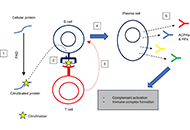 Rheumatoid arthritis: a complex tale of autoimmune hypersensitivityOpen AccessReviewRheumatoid arthritis (RA) is a complex autoimmune disorder characterized by a spectrum of hypersensitivity reactions, encompassing Type II, Type III, and Type IV responses. Firstly, RA is marked by ...Jihye Heo ... Jea-Hyun BaekPublished: June 20, 2024 Explor Immunol. DOI: 10.37349/ei.2024.00146
Rheumatoid arthritis: a complex tale of autoimmune hypersensitivityOpen AccessReviewRheumatoid arthritis (RA) is a complex autoimmune disorder characterized by a spectrum of hypersensitivity reactions, encompassing Type II, Type III, and Type IV responses. Firstly, RA is marked by ...Jihye Heo ... Jea-Hyun BaekPublished: June 20, 2024 Explor Immunol. DOI: 10.37349/ei.2024.00146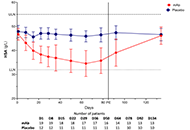 Safety and tolerability of anti-FcRn monoclonal antibody in thyroid autoimmunityOpen AccessOriginal ArticleAim: The clinical symptoms of autoantibody (AAb)-mediated autoimmune diseases (AID) usually correlate with the AAb-titer. Immunoglobulins (Igs) of the IgG type are actively recycled by the neonat...Jan Wolf ... George J. KahalyPublished: June 20, 2024 Explor Immunol. DOI: 10.37349/ei.2024.00145
Safety and tolerability of anti-FcRn monoclonal antibody in thyroid autoimmunityOpen AccessOriginal ArticleAim: The clinical symptoms of autoantibody (AAb)-mediated autoimmune diseases (AID) usually correlate with the AAb-titer. Immunoglobulins (Igs) of the IgG type are actively recycled by the neonat...Jan Wolf ... George J. KahalyPublished: June 20, 2024 Explor Immunol. DOI: 10.37349/ei.2024.00145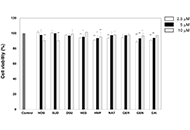 Flavonoids, nobiletin, heptamethoxyflavone, and genistein enhance antigen-presenting cell function in vitroOpen AccessOriginal ArticleAim: Antigen (Ag) presentation by Ag-presenting cells (APCs) is the first step in the generation of adaptive humoral and cellular immune responses. However, there have been few studies on the eff...Yuko Tanaka ... Tohru SakaiPublished: May 29, 2024 Explor Immunol. DOI: 10.37349/ei.2024.00144
Flavonoids, nobiletin, heptamethoxyflavone, and genistein enhance antigen-presenting cell function in vitroOpen AccessOriginal ArticleAim: Antigen (Ag) presentation by Ag-presenting cells (APCs) is the first step in the generation of adaptive humoral and cellular immune responses. However, there have been few studies on the eff...Yuko Tanaka ... Tohru SakaiPublished: May 29, 2024 Explor Immunol. DOI: 10.37349/ei.2024.00144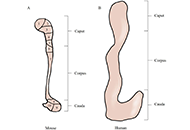 Recent advances in the study of the structure and function of the epididymisOpen AccessReviewTesticular sperm maturation is critical for establishing male fertility. Spermatozoa undergo remodeling of sperm proteins and changes in lipid and ribonucleic acid composition during transport in th...Chuxiong Wang ... Donghui HuangPublished: May 17, 2024 Explor Immunol. DOI: 10.37349/ei.2024.00142
Recent advances in the study of the structure and function of the epididymisOpen AccessReviewTesticular sperm maturation is critical for establishing male fertility. Spermatozoa undergo remodeling of sperm proteins and changes in lipid and ribonucleic acid composition during transport in th...Chuxiong Wang ... Donghui HuangPublished: May 17, 2024 Explor Immunol. DOI: 10.37349/ei.2024.00142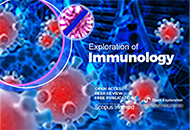 The immune response of nano carbon-based photic-driving vaccines to severe acute respiratory syndrome coronavirus 2Open AccessPerspectiveAs the most severe novel infectious disease in this century, coronavirus disease 2019 (COVID-19) faces tremendous challenges due to the hysteresis of drugs and vaccine development. Elucidating the p...Junming Chen ... Jianshe YangPublished: May 17, 2024 Explor Immunol. DOI: 10.37349/ei.2024.00143
The immune response of nano carbon-based photic-driving vaccines to severe acute respiratory syndrome coronavirus 2Open AccessPerspectiveAs the most severe novel infectious disease in this century, coronavirus disease 2019 (COVID-19) faces tremendous challenges due to the hysteresis of drugs and vaccine development. Elucidating the p...Junming Chen ... Jianshe YangPublished: May 17, 2024 Explor Immunol. DOI: 10.37349/ei.2024.00143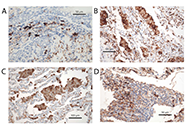 Role of dendritic cells in immunologic and smoking-induced lung diseasesOpen AccessReviewDendritic cells (DCs) are part of the specific and innate immune system and present antigens for lymphocytes but also regulate the actions of cells of the innate immune system such as eosinophilic a...Helmut PopperPublished: April 30, 2024 Explor Immunol. DOI: 10.37349/ei.2024.00141
Role of dendritic cells in immunologic and smoking-induced lung diseasesOpen AccessReviewDendritic cells (DCs) are part of the specific and innate immune system and present antigens for lymphocytes but also regulate the actions of cells of the innate immune system such as eosinophilic a...Helmut PopperPublished: April 30, 2024 Explor Immunol. DOI: 10.37349/ei.2024.00141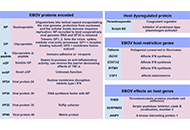 Filoviridae: insights into immune responses to Ebola virusOpen AccessReviewEbola virus (EBOV) is a zoonotic virus comprising of six known different species, designated within the family Filoviridae and genus Ebolavirus. The first recorded outbreak of an EBOV disease (EVD) ...Brent Brown ... Ingo FrickePublished: April 25, 2024 Explor Immunol. DOI: 10.37349/ei.2024.00139
Filoviridae: insights into immune responses to Ebola virusOpen AccessReviewEbola virus (EBOV) is a zoonotic virus comprising of six known different species, designated within the family Filoviridae and genus Ebolavirus. The first recorded outbreak of an EBOV disease (EVD) ...Brent Brown ... Ingo FrickePublished: April 25, 2024 Explor Immunol. DOI: 10.37349/ei.2024.00139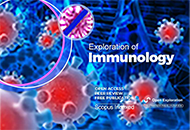 Exploring the possible link between the spike protein immunoglobulin G4 antibodies and cancer progressionOpen AccessReviewRepeated inoculation with messenger RNA (mRNA) vaccines elicits immunoglobulin G4 (IgG4) antibody production. Such an increase in the concentration of specific and non-specific IgG4 antibodies allow...Mikolaj Raszek ... Alberto Rubio-CasillasPublished: April 25, 2024 Explor Immunol. DOI: 10.37349/ei.2024.00140
Exploring the possible link between the spike protein immunoglobulin G4 antibodies and cancer progressionOpen AccessReviewRepeated inoculation with messenger RNA (mRNA) vaccines elicits immunoglobulin G4 (IgG4) antibody production. Such an increase in the concentration of specific and non-specific IgG4 antibodies allow...Mikolaj Raszek ... Alberto Rubio-CasillasPublished: April 25, 2024 Explor Immunol. DOI: 10.37349/ei.2024.00140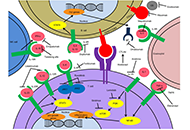 Targeted treatments for immune dysregulation in inborn errors of immunityOpen AccessReviewPrimary immune regulatory disorders (PIRDs) constitute a subset of inborn errors of immunity and are characterized by lymphoproliferation, autoimmunity, malignancy, and infection. Unlike classical p...Nadia Makkoukdji ... Melissa GansPublished: April 23, 2024 Explor Immunol. DOI: 10.37349/ei.2024.00138
Targeted treatments for immune dysregulation in inborn errors of immunityOpen AccessReviewPrimary immune regulatory disorders (PIRDs) constitute a subset of inborn errors of immunity and are characterized by lymphoproliferation, autoimmunity, malignancy, and infection. Unlike classical p...Nadia Makkoukdji ... Melissa GansPublished: April 23, 2024 Explor Immunol. DOI: 10.37349/ei.2024.00138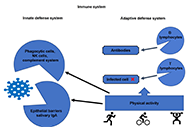 Physical activity, immune system and hypertension: reflections and challenges for future pandemics based on learning from coronavirus disease 2019Open AccessCommentaryFrancisco PitangaPublished: April 17, 2024 Explor Immunol. DOI: 10.37349/ei.2024.00137
Physical activity, immune system and hypertension: reflections and challenges for future pandemics based on learning from coronavirus disease 2019Open AccessCommentaryFrancisco PitangaPublished: April 17, 2024 Explor Immunol. DOI: 10.37349/ei.2024.00137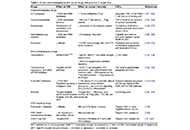 Cancer stem cell, chromosomal instability, and cancer immunityOpen AccessReviewCancer stem cells (CSCs) are a unique population of tumor cells with stem cell-like properties. They are believed to be involved in drug resistance, potential therapy failure, tumor relapse after tr...Laxmi Kumari ... Alka BhatiaPublished: April 02, 2024 Explor Immunol. DOI: 10.37349/ei.2024.00135
Cancer stem cell, chromosomal instability, and cancer immunityOpen AccessReviewCancer stem cells (CSCs) are a unique population of tumor cells with stem cell-like properties. They are believed to be involved in drug resistance, potential therapy failure, tumor relapse after tr...Laxmi Kumari ... Alka BhatiaPublished: April 02, 2024 Explor Immunol. DOI: 10.37349/ei.2024.00135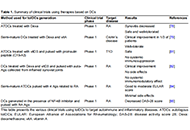 Dendritic cell and co-stimulatory molecule targeted therapy for autoimmune diseases: a review of the newly implemented strategiesOpen AccessReviewDendritic cells (DCs) play an important role in the formation of the immune response, and they are involved in the pathogenesis of autoimmune diseases. Targeting DCs has thus emerged as a new therap...Mazen El Jamal, Farah ShibliPublished: April 02, 2024 Explor Immunol. DOI: 10.37349/ei.2024.00136
Dendritic cell and co-stimulatory molecule targeted therapy for autoimmune diseases: a review of the newly implemented strategiesOpen AccessReviewDendritic cells (DCs) play an important role in the formation of the immune response, and they are involved in the pathogenesis of autoimmune diseases. Targeting DCs has thus emerged as a new therap...Mazen El Jamal, Farah ShibliPublished: April 02, 2024 Explor Immunol. DOI: 10.37349/ei.2024.00136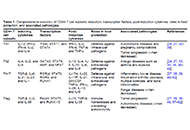 Entrance to the multifaceted world of CD4+ T cell subsetsOpen AccessReviewThis review provides a detailed examination of CD4+ T lymphocyte subsets, crucial components of the immune system originating from the thymus. This study explores the distinct roles and mechanisms o...Murilo Porfírio de Aguiar, Julia Hailer VieiraPublished: March 05, 2024 Explor Immunol. DOI: 10.37349/ei.2024.00134
Entrance to the multifaceted world of CD4+ T cell subsetsOpen AccessReviewThis review provides a detailed examination of CD4+ T lymphocyte subsets, crucial components of the immune system originating from the thymus. This study explores the distinct roles and mechanisms o...Murilo Porfírio de Aguiar, Julia Hailer VieiraPublished: March 05, 2024 Explor Immunol. DOI: 10.37349/ei.2024.00134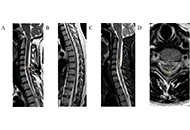 Myelitis associated with COVID-19: clinical, radiological, and laboratory characteristicsOpen AccessOriginal ArticleAim: The current study aimed to describe various types of myelitis associated with a novel coronavirus infection [coronavirus disease 2019 (COVID-19)] as well as to analyze cytokine profiles and cerebrospinal fluid (CSF) parameters in affected patients and to compare them to patients with other immune-mediated disorders—multiple sclerosis (MS), in order to identify possible common pathogenetic pathways and consequently treatment targets. Methods: Clinical, radiological, and laboratory characteristics were studied based on patients’ history. CSF from patients with myelitis associated with COVID-19 (11 patients) was compared with CSF of healthy controls (HC) (7 patients) and patients with MS (37 patients) from the non-COVID era. CSF cytological examination, protein levels and oligoclonal bands (OCBs) evaluation, severe acute respiratory syndrome coronavirus 2 (SARS-CoV-2) virus detection and cytokine profiling using Bio-Plex Pro Human Inflammation Panel 1, 37-Plex were performed....Aleksandra Kozlova ... Maria ZakharovaPublished: February 29, 2024 Explor Immunol. DOI: 10.37349/ei.2024.00132
Myelitis associated with COVID-19: clinical, radiological, and laboratory characteristicsOpen AccessOriginal ArticleAim: The current study aimed to describe various types of myelitis associated with a novel coronavirus infection [coronavirus disease 2019 (COVID-19)] as well as to analyze cytokine profiles and cerebrospinal fluid (CSF) parameters in affected patients and to compare them to patients with other immune-mediated disorders—multiple sclerosis (MS), in order to identify possible common pathogenetic pathways and consequently treatment targets. Methods: Clinical, radiological, and laboratory characteristics were studied based on patients’ history. CSF from patients with myelitis associated with COVID-19 (11 patients) was compared with CSF of healthy controls (HC) (7 patients) and patients with MS (37 patients) from the non-COVID era. CSF cytological examination, protein levels and oligoclonal bands (OCBs) evaluation, severe acute respiratory syndrome coronavirus 2 (SARS-CoV-2) virus detection and cytokine profiling using Bio-Plex Pro Human Inflammation Panel 1, 37-Plex were performed....Aleksandra Kozlova ... Maria ZakharovaPublished: February 29, 2024 Explor Immunol. DOI: 10.37349/ei.2024.00132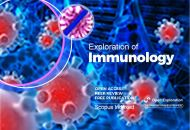 Periodontitis and lipopolysaccharides: How far have we understood?Open AccessReviewPeriodontitis is a ubiquitous chronic inflammatory worldwide disease. The multiplicity of gram-negative microbiomes and their endotoxins, such as lipopolysaccharides (LPS), play a crucial role in it...Spoorthi Ravi Banavar ... Suan Phaik KhooPublished: February 29, 2024 Explor Immunol. DOI: 10.37349/ei.2024.00133
Periodontitis and lipopolysaccharides: How far have we understood?Open AccessReviewPeriodontitis is a ubiquitous chronic inflammatory worldwide disease. The multiplicity of gram-negative microbiomes and their endotoxins, such as lipopolysaccharides (LPS), play a crucial role in it...Spoorthi Ravi Banavar ... Suan Phaik KhooPublished: February 29, 2024 Explor Immunol. DOI: 10.37349/ei.2024.00133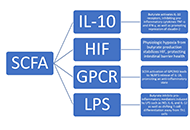 Nutritional effects on mucosal integrity and immune functionOpen AccessReviewThe intestinal mucosal barrier plays a critical role in maintaining the integrity of the gastrointestinal (GI) tract and protecting the body from harmful toxins and pathogens. Nutrition additionally...Lindsey B. Cundra ... David A. JohnsonPublished: February 28, 2024 Explor Immunol. DOI: 10.37349/ei.2024.00130
Nutritional effects on mucosal integrity and immune functionOpen AccessReviewThe intestinal mucosal barrier plays a critical role in maintaining the integrity of the gastrointestinal (GI) tract and protecting the body from harmful toxins and pathogens. Nutrition additionally...Lindsey B. Cundra ... David A. JohnsonPublished: February 28, 2024 Explor Immunol. DOI: 10.37349/ei.2024.00130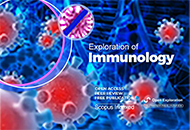 Immune cell dynamics in male reproductive health: orchestrating immune privilege and inflammatory responsesOpen AccessMini ReviewEpididymitis or epididymo-orchitis is a common urological condition in males characterized by scrotal pain, swelling, and potential urinary symptoms. Although antibiotics can eliminate the causative...Yiming Zhang ... Ming WangPublished: February 28, 2024 Explor Immunol. DOI: 10.37349/ei.2024.00131
Immune cell dynamics in male reproductive health: orchestrating immune privilege and inflammatory responsesOpen AccessMini ReviewEpididymitis or epididymo-orchitis is a common urological condition in males characterized by scrotal pain, swelling, and potential urinary symptoms. Although antibiotics can eliminate the causative...Yiming Zhang ... Ming WangPublished: February 28, 2024 Explor Immunol. DOI: 10.37349/ei.2024.00131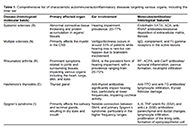 Decoding the impact of autoinflammatory/autoimmune diseases on inner ear harmony and hearing lossOpen AccessReviewAutoimmune and autoinflammatory diseases affecting the inner ear can cause symptoms such as hearing loss, imbalance, vertigo, and tinnitus, presenting demanding and often underdiagnosed conditions. ...Michail Athanasopoulos ... Ioannis AthanasopoulosPublished: February 22, 2024 Explor Immunol. DOI: 10.37349/ei.2024.00129
Decoding the impact of autoinflammatory/autoimmune diseases on inner ear harmony and hearing lossOpen AccessReviewAutoimmune and autoinflammatory diseases affecting the inner ear can cause symptoms such as hearing loss, imbalance, vertigo, and tinnitus, presenting demanding and often underdiagnosed conditions. ...Michail Athanasopoulos ... Ioannis AthanasopoulosPublished: February 22, 2024 Explor Immunol. DOI: 10.37349/ei.2024.00129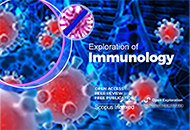 The mammary gland is intolerant to bacterial intrusionOpen AccessReviewMammals depend on the secretion of milk to rear their offspring, which exposes the organ in charge of the function, the mammary gland (MG), to bacterial threat. The essential driving force that cond...Pascal RainardPublished: February 06, 2024 Explor Immunol. DOI: 10.37349/ei.2024.00128
The mammary gland is intolerant to bacterial intrusionOpen AccessReviewMammals depend on the secretion of milk to rear their offspring, which exposes the organ in charge of the function, the mammary gland (MG), to bacterial threat. The essential driving force that cond...Pascal RainardPublished: February 06, 2024 Explor Immunol. DOI: 10.37349/ei.2024.00128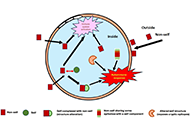 Generation and pathogenicity of autoantibodies associated to thrombosis and hemostasisOpen AccessReviewMany acquired bleeding and thrombotic complications are provoked by autoantibodies to blood coagulation factors, or to hemostasis inhibitors and regulatory proteins. If occurrence of those antibodie...Jean AmiralPublished: February 05, 2024 Explor Immunol. DOI: 10.37349/ei.2024.00127
Generation and pathogenicity of autoantibodies associated to thrombosis and hemostasisOpen AccessReviewMany acquired bleeding and thrombotic complications are provoked by autoantibodies to blood coagulation factors, or to hemostasis inhibitors and regulatory proteins. If occurrence of those antibodie...Jean AmiralPublished: February 05, 2024 Explor Immunol. DOI: 10.37349/ei.2024.00127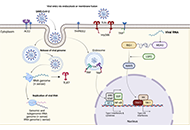 Paradigm of immune dysregulation in coronavirus disease-2019 infectionOpen AccessReviewThe coronavirus disease 2019 (COVID-19) pandemic cost 7–8 million deaths worldwide, creating an unprecedented health and economic crisis. Affecting 700 million people globally, the magnitude of th...Om Saswat Sahoo ... Subhradip KarmakarPublished: January 31, 2024 Explor Immunol. DOI: 10.37349/ei.2024.00126
Paradigm of immune dysregulation in coronavirus disease-2019 infectionOpen AccessReviewThe coronavirus disease 2019 (COVID-19) pandemic cost 7–8 million deaths worldwide, creating an unprecedented health and economic crisis. Affecting 700 million people globally, the magnitude of th...Om Saswat Sahoo ... Subhradip KarmakarPublished: January 31, 2024 Explor Immunol. DOI: 10.37349/ei.2024.00126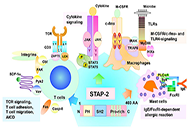 Potential therapeutic applications of targeting signal-transducing adaptor protein-2 in autoimmune diseasesOpen AccessPerspectiveAdaptor proteins are involved in various immune responses via the modulation of many signaling pathways. Signal-transducing adaptor protein-2 (STAP-2) is an adaptor protein that contains typical dom...Yuto Sasaki ... Tadashi MatsudaPublished: December 28, 2023 Explor Immunol. DOI: 10.37349/ei.2023.00125
Potential therapeutic applications of targeting signal-transducing adaptor protein-2 in autoimmune diseasesOpen AccessPerspectiveAdaptor proteins are involved in various immune responses via the modulation of many signaling pathways. Signal-transducing adaptor protein-2 (STAP-2) is an adaptor protein that contains typical dom...Yuto Sasaki ... Tadashi MatsudaPublished: December 28, 2023 Explor Immunol. DOI: 10.37349/ei.2023.00125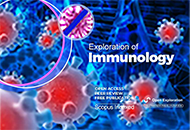 High percentage of blood-based T-cell receptor gamma V9-JP recombinations associated with amyotrophic lateral sclerosis: extensive retention of the JP KKIK amino acid motifOpen AccessCommentaryExome and RNAseq files prepared from blood samples can be mined for adaptive immune receptor recombinations and thus for the complementarity determining region-3 (CDR3) amino acid (AA) sequences, im...George Blanck ... Joanna J. SongPublished: December 22, 2023 Explor Immunol. DOI: 10.37349/ei.2023.00124
High percentage of blood-based T-cell receptor gamma V9-JP recombinations associated with amyotrophic lateral sclerosis: extensive retention of the JP KKIK amino acid motifOpen AccessCommentaryExome and RNAseq files prepared from blood samples can be mined for adaptive immune receptor recombinations and thus for the complementarity determining region-3 (CDR3) amino acid (AA) sequences, im...George Blanck ... Joanna J. SongPublished: December 22, 2023 Explor Immunol. DOI: 10.37349/ei.2023.00124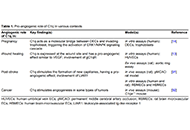 The role of complement component C1q in angiogenesisOpen AccessReviewThe complement component C1q plays a role as a pro-angiogenic factor in different contexts, acting in a complement-independent way. For example, this molecule is able to foster the remodeling of the...Mariagiulia Spazzapan ... Roberta BullaPublished: December 14, 2023 Explor Immunol. DOI: 10.37349/ei.2023.00122
The role of complement component C1q in angiogenesisOpen AccessReviewThe complement component C1q plays a role as a pro-angiogenic factor in different contexts, acting in a complement-independent way. For example, this molecule is able to foster the remodeling of the...Mariagiulia Spazzapan ... Roberta BullaPublished: December 14, 2023 Explor Immunol. DOI: 10.37349/ei.2023.00122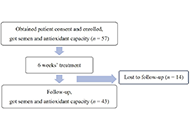 Ningmitai capsule improves the semen quality of male infertile with chronic prostatitis by antioxidant and anti-inflammatoryOpen AccessOriginal ArticleAim: To observe the effects of Ningmitai capsule on semen parameters of infertile patients with chronic prostatitis (CP) and explore the mechanisms. Methods: A total of 43 patients diagnose...Xiaoyu Wu ... Xinzong ZhangPublished: December 14, 2023 Explor Immunol. DOI: 10.37349/ei.2023.00123
Ningmitai capsule improves the semen quality of male infertile with chronic prostatitis by antioxidant and anti-inflammatoryOpen AccessOriginal ArticleAim: To observe the effects of Ningmitai capsule on semen parameters of infertile patients with chronic prostatitis (CP) and explore the mechanisms. Methods: A total of 43 patients diagnose...Xiaoyu Wu ... Xinzong ZhangPublished: December 14, 2023 Explor Immunol. DOI: 10.37349/ei.2023.00123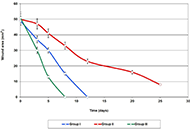 Treatment of a non-healing oral wound in diabetic-induced ratsOpen AccessOriginal ArticleAim: Non-healing wounds are one of the most substantial and difficult problems to treat. Wound healing involves a sequence of complex biological processes, but often the oral cavity microbiota ad...Lia Karalashvili ... Zurab KakabadzePublished: December 08, 2023 Explor Immunol. DOI: 10.37349/ei.2023.00121
Treatment of a non-healing oral wound in diabetic-induced ratsOpen AccessOriginal ArticleAim: Non-healing wounds are one of the most substantial and difficult problems to treat. Wound healing involves a sequence of complex biological processes, but often the oral cavity microbiota ad...Lia Karalashvili ... Zurab KakabadzePublished: December 08, 2023 Explor Immunol. DOI: 10.37349/ei.2023.00121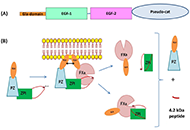 An update on anti-protein Z antibodiesOpen AccessReviewProtein Z (PZ) is a vitamin K-dependent protein that acts as a cofactor for the inhibition of activated factor X by the PZ-dependent protease inhibitor, an anticoagulant protein of the serpin superf...Tiffany Pascreau ... Marc VassePublished: December 05, 2023 Explor Immunol. DOI: 10.37349/ei.2023.00120
An update on anti-protein Z antibodiesOpen AccessReviewProtein Z (PZ) is a vitamin K-dependent protein that acts as a cofactor for the inhibition of activated factor X by the PZ-dependent protease inhibitor, an anticoagulant protein of the serpin superf...Tiffany Pascreau ... Marc VassePublished: December 05, 2023 Explor Immunol. DOI: 10.37349/ei.2023.00120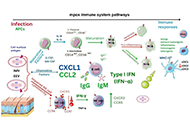 Immunopathogenesis of Orthopoxviridae: insights into immunology from smallpox to monkeypox (mpox)Open AccessReviewSince 2019, notable global viral outbreaks have occurred necessitating further research and healthcare system investigations. Following the coronavirus disease 2019 (COVID-19) pandemic, in 2022, whi...Brent Brown ... Enrique Chacon-CruzPublished: November 21, 2023 Explor Immunol. DOI: 10.37349/ei.2023.00119
Immunopathogenesis of Orthopoxviridae: insights into immunology from smallpox to monkeypox (mpox)Open AccessReviewSince 2019, notable global viral outbreaks have occurred necessitating further research and healthcare system investigations. Following the coronavirus disease 2019 (COVID-19) pandemic, in 2022, whi...Brent Brown ... Enrique Chacon-CruzPublished: November 21, 2023 Explor Immunol. DOI: 10.37349/ei.2023.00119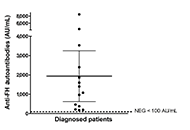 Anti-factor H autoantibody-associated hemolytic uremic syndrome in an Argentine pediatric cohortOpen AccessOriginal ArticleAim: To describe the clinical characteristics and frequency of anti-factor H (FH) autoantibody-associated atypical hemolytic uremic syndrome (aHUS) in the first cohort of Argentine patients. ...Célia Dos Santos ... Analía Sánchez-LucerosPublished: November 10, 2023 Explor Immunol. DOI: 10.37349/ei.2023.00118
Anti-factor H autoantibody-associated hemolytic uremic syndrome in an Argentine pediatric cohortOpen AccessOriginal ArticleAim: To describe the clinical characteristics and frequency of anti-factor H (FH) autoantibody-associated atypical hemolytic uremic syndrome (aHUS) in the first cohort of Argentine patients. ...Célia Dos Santos ... Analía Sánchez-LucerosPublished: November 10, 2023 Explor Immunol. DOI: 10.37349/ei.2023.00118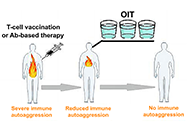 Immune-based, multifaceted inactivation of pathogenic T lymphocytes in treating autoimmune diseasesOpen AccessPerspectiveImmunotherapeutic treatment of autoimmune diseases should aim to inactivate autoaggressive memory T-cells and restore immune tolerance. It is envisaged that three approaches could be used to achieve...Victor Ivanovich Seledtsov ... Alexei A. von DelwigPublished: October 30, 2023 Explor Immunol. DOI: 10.37349/ei.2023.00117
Immune-based, multifaceted inactivation of pathogenic T lymphocytes in treating autoimmune diseasesOpen AccessPerspectiveImmunotherapeutic treatment of autoimmune diseases should aim to inactivate autoaggressive memory T-cells and restore immune tolerance. It is envisaged that three approaches could be used to achieve...Victor Ivanovich Seledtsov ... Alexei A. von DelwigPublished: October 30, 2023 Explor Immunol. DOI: 10.37349/ei.2023.00117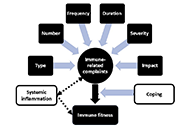 The concept and assessment of immune fitnessOpen AccessEditorialJoris C. Verster ... Johan GarssenPublished: October 27, 2023 Explor Immunol. DOI: 10.37349/ei.2023.00116
The concept and assessment of immune fitnessOpen AccessEditorialJoris C. Verster ... Johan GarssenPublished: October 27, 2023 Explor Immunol. DOI: 10.37349/ei.2023.00116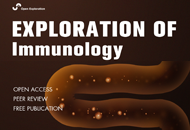 Loss of regulation of T helper 17 cells: a definitive factor for critical cases of coronavirus disease 2019Open AccessReviewOne of the greatest challenges in the study of coronavirus disease 2019 (COVID-19) has been to establish the determining factors in the severity of the disease. Through extensive research efforts, a...Miguel Angel Pardiño-Vega, Norma Estela Herrera-GonzálezPublished: October 16, 2023 Explor Immunol. DOI: 10.37349/ei.2023.00115
Loss of regulation of T helper 17 cells: a definitive factor for critical cases of coronavirus disease 2019Open AccessReviewOne of the greatest challenges in the study of coronavirus disease 2019 (COVID-19) has been to establish the determining factors in the severity of the disease. Through extensive research efforts, a...Miguel Angel Pardiño-Vega, Norma Estela Herrera-GonzálezPublished: October 16, 2023 Explor Immunol. DOI: 10.37349/ei.2023.00115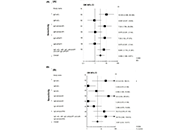 Risk factors and recurrent thrombosis in primary antiphospholipid syndromeOpen AccessOriginal ArticleAim: The study aims to evaluate the incidence of recurrent thromboses in patients with primary antiphospholipid syndrome (PAPS) and its association with the presence of different antiphospholipid...Fariza A. Cheldieva ... Tatiana M. ReshetnyakPublished: October 12, 2023 Explor Immunol. DOI: 10.37349/ei.2023.00114
Risk factors and recurrent thrombosis in primary antiphospholipid syndromeOpen AccessOriginal ArticleAim: The study aims to evaluate the incidence of recurrent thromboses in patients with primary antiphospholipid syndrome (PAPS) and its association with the presence of different antiphospholipid...Fariza A. Cheldieva ... Tatiana M. ReshetnyakPublished: October 12, 2023 Explor Immunol. DOI: 10.37349/ei.2023.00114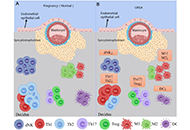 Research progress of immune balance and genetic polymorphism in unexplained recurrent abortionOpen AccessReviewThe etiology of recurrent spontaneous abortion (RSA) is extremely complex, as there are 40–50% of patients with unexplained miscarriages, known as unexplained RSA (URSA). URSA affects approximatel...Yafei Kang ... Donghui HuangPublished: October 12, 2023 Explor Immunol. DOI: 10.37349/ei.2023.00113
Research progress of immune balance and genetic polymorphism in unexplained recurrent abortionOpen AccessReviewThe etiology of recurrent spontaneous abortion (RSA) is extremely complex, as there are 40–50% of patients with unexplained miscarriages, known as unexplained RSA (URSA). URSA affects approximatel...Yafei Kang ... Donghui HuangPublished: October 12, 2023 Explor Immunol. DOI: 10.37349/ei.2023.00113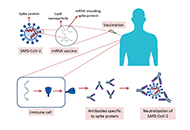 Effect of coronavirus disease 2019 on the vaccine development paradigmOpen AccessReviewVaccines are prophylactic medical products effectively used against infectious diseases. Although a high amount of vaccine studies are conducted at the preclinical stage, the number of approved vacc...Sezer OkayPublished: October 10, 2023 Explor Immunol. DOI: 10.37349/ei.2023.00111
Effect of coronavirus disease 2019 on the vaccine development paradigmOpen AccessReviewVaccines are prophylactic medical products effectively used against infectious diseases. Although a high amount of vaccine studies are conducted at the preclinical stage, the number of approved vacc...Sezer OkayPublished: October 10, 2023 Explor Immunol. DOI: 10.37349/ei.2023.00111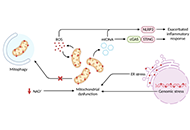 Mitochondrial dysfunction at the cornerstone of inflammatory exacerbation in aged macrophagesOpen AccessReviewImmunosenescence encompasses multiple age-related adaptations that result in increased susceptibility to infections, chronic inflammatory disorders, and higher mortality risk. Macrophages are key in...Rafael Moura Maurmann ... Brandt D. PencePublished: October 11, 2023 Explor Immunol. DOI: 10.37349/ei.2023.00112
Mitochondrial dysfunction at the cornerstone of inflammatory exacerbation in aged macrophagesOpen AccessReviewImmunosenescence encompasses multiple age-related adaptations that result in increased susceptibility to infections, chronic inflammatory disorders, and higher mortality risk. Macrophages are key in...Rafael Moura Maurmann ... Brandt D. PencePublished: October 11, 2023 Explor Immunol. DOI: 10.37349/ei.2023.00112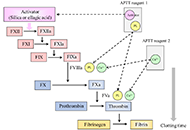 Update on laboratory practice for the diagnosis of lupus anticoagulant and the antiphospholipid syndromeOpen AccessReviewAntiphospholipid syndrome (APS) is defined as an autoimmune and prothrombotic disorder in patients with the persistent presence of antiphospholipid antibodies (aPLs). In the classification criteria,...Osamu Kumano ... Jean AmiralPublished: October 08, 2023 Explor Immunol. DOI: 10.37349/ei.2023.00110
Update on laboratory practice for the diagnosis of lupus anticoagulant and the antiphospholipid syndromeOpen AccessReviewAntiphospholipid syndrome (APS) is defined as an autoimmune and prothrombotic disorder in patients with the persistent presence of antiphospholipid antibodies (aPLs). In the classification criteria,...Osamu Kumano ... Jean AmiralPublished: October 08, 2023 Explor Immunol. DOI: 10.37349/ei.2023.00110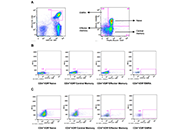 Vitamin D, ageing, and the immune systemOpen AccessReviewChanges occurring in the immune system along the ageing process increase the risk of infection, susceptibility to tumor development, and autoimmunity. Interventions such as physical exercise, supple...Valquiria BuenoPublished: August 31, 2023 Explor Immunol. DOI: 10.37349/ei.2023.00106
Vitamin D, ageing, and the immune systemOpen AccessReviewChanges occurring in the immune system along the ageing process increase the risk of infection, susceptibility to tumor development, and autoimmunity. Interventions such as physical exercise, supple...Valquiria BuenoPublished: August 31, 2023 Explor Immunol. DOI: 10.37349/ei.2023.00106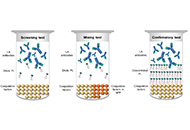 Analytical dilemmas in lupus anticoagulant detectionOpen AccessReviewAccurate lupus anticoagulant (LA) detection is crucial to antiphospholipid syndrome (APS) diagnosis. Detection is based on LA functional behavior in coagulation assays irrespective of epitope specif...Gary W. MoorePublished: August 31, 2023 Explor Immunol. DOI: 10.37349/ei.2023.00104
Analytical dilemmas in lupus anticoagulant detectionOpen AccessReviewAccurate lupus anticoagulant (LA) detection is crucial to antiphospholipid syndrome (APS) diagnosis. Detection is based on LA functional behavior in coagulation assays irrespective of epitope specif...Gary W. MoorePublished: August 31, 2023 Explor Immunol. DOI: 10.37349/ei.2023.00104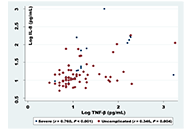 Inflammatory immune mediators and Plasmodium falciparum infection: a cross-sectional study among Sudanese patients with severe and uncomplicated malariaOpen AccessOriginal ArticleAim: A number of questions remain unanswered concerning how infected individuals regulate their immune response to Plasmodium falciparum (P. falciparum) parasites at varying levels of exposure. D...Dia Aldeen Alfaki ... Mohamed Mubarak ElbasheirPublished: August 31, 2023 Explor Immunol. DOI: 10.37349/ei.2023.00109
Inflammatory immune mediators and Plasmodium falciparum infection: a cross-sectional study among Sudanese patients with severe and uncomplicated malariaOpen AccessOriginal ArticleAim: A number of questions remain unanswered concerning how infected individuals regulate their immune response to Plasmodium falciparum (P. falciparum) parasites at varying levels of exposure. D...Dia Aldeen Alfaki ... Mohamed Mubarak ElbasheirPublished: August 31, 2023 Explor Immunol. DOI: 10.37349/ei.2023.00109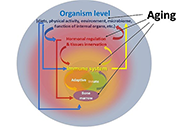 Immune system rejuvenation—approaches and real achievementsOpen AccessReviewInterest in the mechanisms of aging of the immune system has not faded over the past 100 years, and it is caused by the immune-mediated development of age-related pathology, including autoimmune org...Iryna PishelPublished: August 31, 2023 Explor Immunol. DOI: 10.37349/ei.2023.00105
Immune system rejuvenation—approaches and real achievementsOpen AccessReviewInterest in the mechanisms of aging of the immune system has not faded over the past 100 years, and it is caused by the immune-mediated development of age-related pathology, including autoimmune org...Iryna PishelPublished: August 31, 2023 Explor Immunol. DOI: 10.37349/ei.2023.00105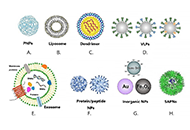 The emergence of nanovaccines as a new paradigm in virological vaccinology: a reviewOpen AccessReviewVaccination has made an enormous contribution to global health. Treatment resistance for infectious diseases is growing quickly, and chemotherapeutic toxicity in cancer means that vaccines must be m...Chittaranjan Baruah ... Bhabesh DekaPublished: August 31, 2023 Explor Immunol. DOI: 10.37349/ei.2023.00107
The emergence of nanovaccines as a new paradigm in virological vaccinology: a reviewOpen AccessReviewVaccination has made an enormous contribution to global health. Treatment resistance for infectious diseases is growing quickly, and chemotherapeutic toxicity in cancer means that vaccines must be m...Chittaranjan Baruah ... Bhabesh DekaPublished: August 31, 2023 Explor Immunol. DOI: 10.37349/ei.2023.00107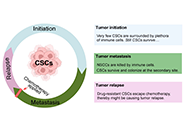 Immune evasion by cancer stem cells ensures tumor initiation and failure of immunotherapyOpen AccessReviewCancer stem cells (CSCs) are a small subpopulation of cells that drive the formation and progression of tumors. However, during tumor initiation, how CSCs communicate with neighbouring immune cells ...Sourio Chakraborty ... Tanya DasPublished: August 31, 2023 Explor Immunol. DOI: 10.37349/ei.2023.00108
Immune evasion by cancer stem cells ensures tumor initiation and failure of immunotherapyOpen AccessReviewCancer stem cells (CSCs) are a small subpopulation of cells that drive the formation and progression of tumors. However, during tumor initiation, how CSCs communicate with neighbouring immune cells ...Sourio Chakraborty ... Tanya DasPublished: August 31, 2023 Explor Immunol. DOI: 10.37349/ei.2023.00108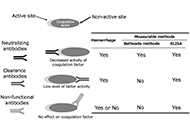 Considerations for simultaneous detection of autoantibodies to coagulation factor and lupus anticoagulantOpen AccessReviewIn patients with autoimmune coagulation factor deficiency (AiCFD), the production of autoantibodies that inhibit coagulation factors in the blood reduces the activity of those relevant coagulation f...Masahiro Ieko ... Akitada IchinosePublished: August 30, 2023 Explor Immunol. DOI: 10.37349/ei.2023.00103
Considerations for simultaneous detection of autoantibodies to coagulation factor and lupus anticoagulantOpen AccessReviewIn patients with autoimmune coagulation factor deficiency (AiCFD), the production of autoantibodies that inhibit coagulation factors in the blood reduces the activity of those relevant coagulation f...Masahiro Ieko ... Akitada IchinosePublished: August 30, 2023 Explor Immunol. DOI: 10.37349/ei.2023.00103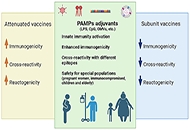 Trained-immunity and cross-reactivity for protection: insights from the coronavirus disease 2019 and monkeypox emergencies for vaccine developmentOpen AccessReviewThe emergence and re-emergence of pathogens is a public-health concern, which has become more evident after the coronavirus disease 2019 (COVID-19) pandemic and the monkeypox outbreaks in early 2022...Amanda Izeli Portilho, Elizabeth De GaspariPublished: August 24, 2023 Explor Immunol. DOI: 10.37349/ei.2023.00102
Trained-immunity and cross-reactivity for protection: insights from the coronavirus disease 2019 and monkeypox emergencies for vaccine developmentOpen AccessReviewThe emergence and re-emergence of pathogens is a public-health concern, which has become more evident after the coronavirus disease 2019 (COVID-19) pandemic and the monkeypox outbreaks in early 2022...Amanda Izeli Portilho, Elizabeth De GaspariPublished: August 24, 2023 Explor Immunol. DOI: 10.37349/ei.2023.00102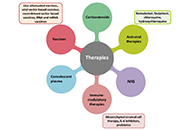 COVID-19 induced ARDS: immunopathology and therapeuticsOpen AccessReviewThe coronavirus disease-2019 (COVID-19) pandemic is a significant threat in the modern era. Clinical studies show that the most common symptom of severe COVID-19 is viral pneumonia-induced acute res...Sneha Das ... Rupesh K. SrivastavaPublished: August 04, 2023 Explor Immunol. DOI: 10.37349/ei.2023.00101
COVID-19 induced ARDS: immunopathology and therapeuticsOpen AccessReviewThe coronavirus disease-2019 (COVID-19) pandemic is a significant threat in the modern era. Clinical studies show that the most common symptom of severe COVID-19 is viral pneumonia-induced acute res...Sneha Das ... Rupesh K. SrivastavaPublished: August 04, 2023 Explor Immunol. DOI: 10.37349/ei.2023.00101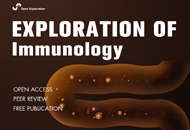 The aging process and its relation to periodontal conditionsOpen AccessReviewPeriodontal tissue destruction can cause complaints for sufferers. Inflammatory conditions of the gingiva, bleeding gums, and even tooth loss are clinical features of the destruction of the periodon...Pitu WulandariPublished: June 30, 2023 Explor Immunol. DOI: 10.37349/ei.2023.00098
The aging process and its relation to periodontal conditionsOpen AccessReviewPeriodontal tissue destruction can cause complaints for sufferers. Inflammatory conditions of the gingiva, bleeding gums, and even tooth loss are clinical features of the destruction of the periodon...Pitu WulandariPublished: June 30, 2023 Explor Immunol. DOI: 10.37349/ei.2023.00098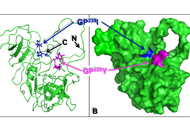 Conformational and functional regulation of the chicken tumor virus number 10 (CT10) regulator of kinase II (CrkII) adaptor protein by cyclophilin AOpen AccessReviewThe Src homology 2 (SH2) and SH3 domain-containing chicken tumor virus number 10 (CT10) regulator of kinase (Crk) adaptor proteins include three cellular members that serve as integral constituents ...Noah IsakovPublished: June 30, 2023 Explor Immunol. DOI: 10.37349/ei.2023.00099
Conformational and functional regulation of the chicken tumor virus number 10 (CT10) regulator of kinase II (CrkII) adaptor protein by cyclophilin AOpen AccessReviewThe Src homology 2 (SH2) and SH3 domain-containing chicken tumor virus number 10 (CT10) regulator of kinase (Crk) adaptor proteins include three cellular members that serve as integral constituents ...Noah IsakovPublished: June 30, 2023 Explor Immunol. DOI: 10.37349/ei.2023.00099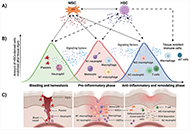 Immune response: the Achilles’ heel of the stem cell-based regenerative therapiesOpen AccessReviewBesides trauma, several pathological conditions which directly affect the normal functioning of organs, require new therapeutic strategies to repair damaged or diseased tissues. Tissue regeneration ...Cláudia S. Oliveira, Freni K. TavariaPublished: June 30, 2023 Explor Immunol. DOI: 10.37349/ei.2023.00100
Immune response: the Achilles’ heel of the stem cell-based regenerative therapiesOpen AccessReviewBesides trauma, several pathological conditions which directly affect the normal functioning of organs, require new therapeutic strategies to repair damaged or diseased tissues. Tissue regeneration ...Cláudia S. Oliveira, Freni K. TavariaPublished: June 30, 2023 Explor Immunol. DOI: 10.37349/ei.2023.00100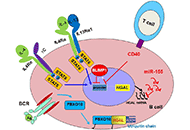 Role of an adaptor protein human germinal center-associated lymphoma (HGAL) in cell signaling and lymphomagenesisOpen AccessReviewHuman germinal center (GC)-associated lymphoma (HGAL) is a multi-domain adaptor protein expressed in GC B lymphocytes, T follicular helper (Tfh) cells and lymphomas derived from these cells. HGAL ex...Xiaoyu Jiang, Izidore S. LossosPublished: June 28, 2023 Explor Immunol. DOI: 10.37349/ei.2023.00097
Role of an adaptor protein human germinal center-associated lymphoma (HGAL) in cell signaling and lymphomagenesisOpen AccessReviewHuman germinal center (GC)-associated lymphoma (HGAL) is a multi-domain adaptor protein expressed in GC B lymphocytes, T follicular helper (Tfh) cells and lymphomas derived from these cells. HGAL ex...Xiaoyu Jiang, Izidore S. LossosPublished: June 28, 2023 Explor Immunol. DOI: 10.37349/ei.2023.00097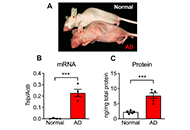 STIM/Orai-mediated calcium entry elicits spontaneous TSLP overproduction in epidermal cells of atopic dermatitis miceOpen AccessOriginal ArticleAim: Atopic dermatitis (AD) is a pruritic, chronic inflammatory skin disease. Thymic stromal lymphopoietin (TSLP) is highly expressed in the epidermis of patients with AD and induces T helper 2 (...Masanori Fujii ... Susumu OhyaPublished: June 11, 2023 Explor Immunol. DOI: 10.37349/ei.2023.00096
STIM/Orai-mediated calcium entry elicits spontaneous TSLP overproduction in epidermal cells of atopic dermatitis miceOpen AccessOriginal ArticleAim: Atopic dermatitis (AD) is a pruritic, chronic inflammatory skin disease. Thymic stromal lymphopoietin (TSLP) is highly expressed in the epidermis of patients with AD and induces T helper 2 (...Masanori Fujii ... Susumu OhyaPublished: June 11, 2023 Explor Immunol. DOI: 10.37349/ei.2023.00096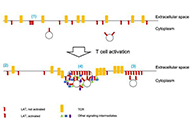 Localization in vesicles, clusters and supramolecular complexes as key elements of LAT functionOpen AccessPerspectiveLinker for activation of T cells (LAT) is a central adaptor protein in proximal T cell activation. A key element of its adaptor function is the efficiency with which LAT interacts with its binding p...Laura E. McMillan, Christoph WülfingPublished: April 27, 2023 Explor Immunol. DOI: 10.37349/ei.2023.00094
Localization in vesicles, clusters and supramolecular complexes as key elements of LAT functionOpen AccessPerspectiveLinker for activation of T cells (LAT) is a central adaptor protein in proximal T cell activation. A key element of its adaptor function is the efficiency with which LAT interacts with its binding p...Laura E. McMillan, Christoph WülfingPublished: April 27, 2023 Explor Immunol. DOI: 10.37349/ei.2023.00094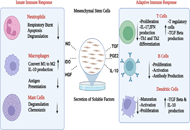 Mesenchymal stem cells—the master immunomodulatorsOpen AccessReviewMesenchymal stem/stromal cells (MSCs) are known as multipotent cells due to their ability to differentiate into various cell lineages of mesoderm origin. Recent developments in stem cell biology hav...Mehak Vohra, Sunil K. AroraPublished: April 27, 2023 Explor Immunol. DOI: 10.37349/ei.2023.00092
Mesenchymal stem cells—the master immunomodulatorsOpen AccessReviewMesenchymal stem/stromal cells (MSCs) are known as multipotent cells due to their ability to differentiate into various cell lineages of mesoderm origin. Recent developments in stem cell biology hav...Mehak Vohra, Sunil K. AroraPublished: April 27, 2023 Explor Immunol. DOI: 10.37349/ei.2023.00092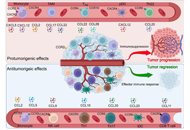 Chemokine-targeted nanoparticles: stimulation of the immune system in cancer immunotherapyOpen AccessReviewSurgery, chemotherapy, radiation therapy, and immunotherapy are potential therapeutic choices for many malignant and metastatic cancers. Despite adverse side effects and pain, surgery and chemothera...Ranjeet Singh ... Partha Pratim MannaPublished: April 27, 2023 Explor Immunol. DOI: 10.37349/ei.2023.00093
Chemokine-targeted nanoparticles: stimulation of the immune system in cancer immunotherapyOpen AccessReviewSurgery, chemotherapy, radiation therapy, and immunotherapy are potential therapeutic choices for many malignant and metastatic cancers. Despite adverse side effects and pain, surgery and chemothera...Ranjeet Singh ... Partha Pratim MannaPublished: April 27, 2023 Explor Immunol. DOI: 10.37349/ei.2023.00093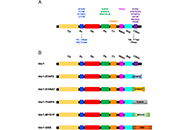 Role of Vav1, a hematopoietic signal transduction molecule, as an adaptor protein in health and diseaseOpen AccessReviewThe growth and differentiation of normal cells are controlled by protein-tyrosine kinases, which serve as receptors for a wide variety of external signals. Small protein modules called Src homology ...Shulamit KatzavPublished: April 28, 2023 Explor Immunol. DOI: 10.37349/ei.2023.00095
Role of Vav1, a hematopoietic signal transduction molecule, as an adaptor protein in health and diseaseOpen AccessReviewThe growth and differentiation of normal cells are controlled by protein-tyrosine kinases, which serve as receptors for a wide variety of external signals. Small protein modules called Src homology ...Shulamit KatzavPublished: April 28, 2023 Explor Immunol. DOI: 10.37349/ei.2023.00095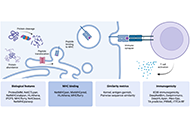 Beyond MHC binding: immunogenicity prediction tools to refine neoantigen selection in cancer patientsOpen AccessReviewIn the last years, multiple efforts have been made to accurately predict neoantigens derived from somatic mutations in cancer patients, either to develop personalized therapeutic vaccines or to stud...Ibel Carri ... María Marcela BarrioPublished: April 25, 2023 Explor Immunol. DOI: 10.37349/ei.2023.00091
Beyond MHC binding: immunogenicity prediction tools to refine neoantigen selection in cancer patientsOpen AccessReviewIn the last years, multiple efforts have been made to accurately predict neoantigens derived from somatic mutations in cancer patients, either to develop personalized therapeutic vaccines or to stud...Ibel Carri ... María Marcela BarrioPublished: April 25, 2023 Explor Immunol. DOI: 10.37349/ei.2023.00091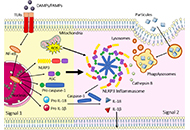 Inflammasomes driven inflammation in lung cancer revisited: a short reviewOpen AccessReviewLung cancer is the leading cause of cancer-related deaths worldwide. The main risk factor for lung cancer is exposure to chemicals present in cigarettes and atmospheric pollutants, which, among othe...Vitor Rodrigues da Costa ... Rodrigo Pinheiro AraldiPublished: March 14, 2023 Explor Immunol. DOI: 10.37349/ei.2023.00090
Inflammasomes driven inflammation in lung cancer revisited: a short reviewOpen AccessReviewLung cancer is the leading cause of cancer-related deaths worldwide. The main risk factor for lung cancer is exposure to chemicals present in cigarettes and atmospheric pollutants, which, among othe...Vitor Rodrigues da Costa ... Rodrigo Pinheiro AraldiPublished: March 14, 2023 Explor Immunol. DOI: 10.37349/ei.2023.00090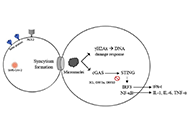 SARS-CoV-2 infection activates the cyclic guanosine monophosphate-adenosine monophosphate synthase-stimulator of interferon genes pathway in the lung: a reviewOpen AccessReviewThe infection of COVID-19 is directly linked to the destruction of lung epithelial cells, and the cyclic guanosine monophosphate-adenosine monophosphate synthase-stimulator of interferon genes (cGAS...Gislei F. Aragão ... Sara Lívia M. TeixeiraPublished: February 28, 2023 Explor Immunol. DOI: 10.37349/ei.2023.00089
SARS-CoV-2 infection activates the cyclic guanosine monophosphate-adenosine monophosphate synthase-stimulator of interferon genes pathway in the lung: a reviewOpen AccessReviewThe infection of COVID-19 is directly linked to the destruction of lung epithelial cells, and the cyclic guanosine monophosphate-adenosine monophosphate synthase-stimulator of interferon genes (cGAS...Gislei F. Aragão ... Sara Lívia M. TeixeiraPublished: February 28, 2023 Explor Immunol. DOI: 10.37349/ei.2023.00089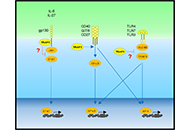 Role of tumor necrosis factor receptor-associated factor 5 in B- and T-lymphocytesOpen AccessReviewTumor necrosis factor receptor (TNFR)-associated factors (TRAFs) are a family of intracellular signaling adaptors that associate with the cytoplasmic tails of a diverse range of lymphocyte receptors...Mari Hikosaka Kuniishi ... Takanori SoPublished: February 27, 2023 Explor Immunol. DOI: 10.37349/ei.2023.00088
Role of tumor necrosis factor receptor-associated factor 5 in B- and T-lymphocytesOpen AccessReviewTumor necrosis factor receptor (TNFR)-associated factors (TRAFs) are a family of intracellular signaling adaptors that associate with the cytoplasmic tails of a diverse range of lymphocyte receptors...Mari Hikosaka Kuniishi ... Takanori SoPublished: February 27, 2023 Explor Immunol. DOI: 10.37349/ei.2023.00088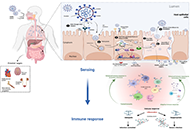 Innate immune cell and severe acute respiratory syndrome coronavirus 2 interactionOpen AccessReviewCoronavirus disease caused by the recently emerged severe acute respiratory syndrome coronavirus 2 (SARS-CoV-2) represents a major public health that has submerged the world into a crisis unpreceden...Naima G. Cortes-PerezPublished: February 26, 2023 Explor Immunol. DOI: 10.37349/ei.2023.00087
Innate immune cell and severe acute respiratory syndrome coronavirus 2 interactionOpen AccessReviewCoronavirus disease caused by the recently emerged severe acute respiratory syndrome coronavirus 2 (SARS-CoV-2) represents a major public health that has submerged the world into a crisis unpreceden...Naima G. Cortes-PerezPublished: February 26, 2023 Explor Immunol. DOI: 10.37349/ei.2023.00087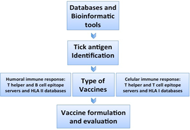 Immunoinformatics and tick vaccinologyOpen AccessReviewImmunoinformatics is an emerging area focused on development and applications of methods used to facilitate vaccine development. There is a growing interest in the field of vaccinology cente...Rodrigo Rosario-Cruz ... Fernando Rosario-DomínguezPublished: February 24, 2023 Explor Immunol. DOI: 10.37349/ei.2023.00085
Immunoinformatics and tick vaccinologyOpen AccessReviewImmunoinformatics is an emerging area focused on development and applications of methods used to facilitate vaccine development. There is a growing interest in the field of vaccinology cente...Rodrigo Rosario-Cruz ... Fernando Rosario-DomínguezPublished: February 24, 2023 Explor Immunol. DOI: 10.37349/ei.2023.00085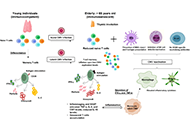 Cytomegalovirus at the crossroads of immunosenescence and oncogenesisOpen AccessReviewHuman cytomegalovirus (HCMV), whose genome is around 235 kb, is a ubiquitous human herpesvirus that infects between 40% and 95% of the population. Though HCMV infection is co...Fidaa Bouezzedine ... Georges HerbeinPublished: February 24, 2023 Explor Immunol. DOI: 10.37349/ei.2023.00086
Cytomegalovirus at the crossroads of immunosenescence and oncogenesisOpen AccessReviewHuman cytomegalovirus (HCMV), whose genome is around 235 kb, is a ubiquitous human herpesvirus that infects between 40% and 95% of the population. Though HCMV infection is co...Fidaa Bouezzedine ... Georges HerbeinPublished: February 24, 2023 Explor Immunol. DOI: 10.37349/ei.2023.00086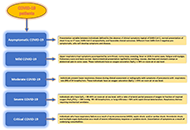 Incursions by severe acute respiratory syndrome coronavirus-2 on the host anti-viral immunity during mild, moderate, and severe coronavirus disease 2019 diseaseOpen AccessReviewThe severe acute respiratory syndrome coronavirus-2 (SARS-CoV-2) infection in the human host can lead to various clinical manifestations, from symptomless carriers to mild to moderate to severe/critical illness. Therefore, the clinical classification of SARS-CoV-2 disease, based on severity, is a reliable way to predict disease states in SARS-CoV-2 infection. Recent studies on genomics, transcriptomics, epigenomics, and immunogenomics, along with spatial analysis of immune cells have delineated and defined the categorization of these disease groups using these high throughout technologies. These technologies hold the promise of providing not only a detailed but a holistic view of SARS-CoV-2-led pathogenesis. The main genomic, cellular, and immunologic features of each disease category, and what separates them spatially and molecularly are discussed in this brief review to provide a foundational spatial understanding of SARS-CoV-2 immunopathogenesis....Nitin Saksena ... Thyago H. CardosoPublished: December 29, 2022 Explor Immunol. DOI: 10.37349/ei.2022.00084
Incursions by severe acute respiratory syndrome coronavirus-2 on the host anti-viral immunity during mild, moderate, and severe coronavirus disease 2019 diseaseOpen AccessReviewThe severe acute respiratory syndrome coronavirus-2 (SARS-CoV-2) infection in the human host can lead to various clinical manifestations, from symptomless carriers to mild to moderate to severe/critical illness. Therefore, the clinical classification of SARS-CoV-2 disease, based on severity, is a reliable way to predict disease states in SARS-CoV-2 infection. Recent studies on genomics, transcriptomics, epigenomics, and immunogenomics, along with spatial analysis of immune cells have delineated and defined the categorization of these disease groups using these high throughout technologies. These technologies hold the promise of providing not only a detailed but a holistic view of SARS-CoV-2-led pathogenesis. The main genomic, cellular, and immunologic features of each disease category, and what separates them spatially and molecularly are discussed in this brief review to provide a foundational spatial understanding of SARS-CoV-2 immunopathogenesis....Nitin Saksena ... Thyago H. CardosoPublished: December 29, 2022 Explor Immunol. DOI: 10.37349/ei.2022.00084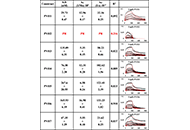 The synergistic effects of the constant region and variable heavy chain families of multimeric immunoglobulin M on its interaction with Fc-mu receptor and antigenOpen AccessOriginal ArticleAim: As the primary response antibody with increasing use as a therapeutic immunoglobulin (Ig) format, IgM is also the largest antibody structure among the five major human isotypes. Spontaneousl...Wei-Li Ling, Samuel Ken-En GanPublished: December 29, 2022 Explor Immunol. DOI: 10.37349/ei.2022.00083
The synergistic effects of the constant region and variable heavy chain families of multimeric immunoglobulin M on its interaction with Fc-mu receptor and antigenOpen AccessOriginal ArticleAim: As the primary response antibody with increasing use as a therapeutic immunoglobulin (Ig) format, IgM is also the largest antibody structure among the five major human isotypes. Spontaneousl...Wei-Li Ling, Samuel Ken-En GanPublished: December 29, 2022 Explor Immunol. DOI: 10.37349/ei.2022.00083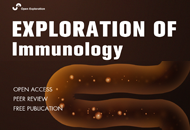 Signal-transducing adaptor protein-2 modulates T-cell functionsOpen AccessReviewImmune responses are orchestrated by controlling the initiation, magnitude, and duration of various signaling pathways. Adaptor proteins act as positive or negative regulators by targeting critical ...Tadashi Matsuda ... Kenji OritaniPublished: December 27, 2022 Explor Immunol. DOI: 10.37349/ei.2022.00082
Signal-transducing adaptor protein-2 modulates T-cell functionsOpen AccessReviewImmune responses are orchestrated by controlling the initiation, magnitude, and duration of various signaling pathways. Adaptor proteins act as positive or negative regulators by targeting critical ...Tadashi Matsuda ... Kenji OritaniPublished: December 27, 2022 Explor Immunol. DOI: 10.37349/ei.2022.00082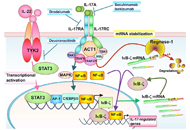 Role of tyrosine kinase 2 signals during progression of psoriasisOpen AccessReviewPsoriasis is a skin disease characterized by scaly erythema, parakeratosis, and epidermal hyperplasia. Application of imiquimod (IMQ), a ligand for Toll-like receptor 7, produces a mouse model for psoriasis. IMQ application induces scaling, erythema, and thickness in skin lesions, and the symptoms are milder in interleukin-23 p19 (Il23p19)-deficient and Il17a-deficient mice than in wild-type mice;...Ryuta Muromoto ... Tadashi MatsudaPublished: December 27, 2022 Explor Immunol. DOI: 10.37349/ei.2022.00081
Role of tyrosine kinase 2 signals during progression of psoriasisOpen AccessReviewPsoriasis is a skin disease characterized by scaly erythema, parakeratosis, and epidermal hyperplasia. Application of imiquimod (IMQ), a ligand for Toll-like receptor 7, produces a mouse model for psoriasis. IMQ application induces scaling, erythema, and thickness in skin lesions, and the symptoms are milder in interleukin-23 p19 (Il23p19)-deficient and Il17a-deficient mice than in wild-type mice;...Ryuta Muromoto ... Tadashi MatsudaPublished: December 27, 2022 Explor Immunol. DOI: 10.37349/ei.2022.00081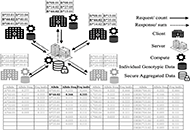 Distributing human leukocyte antigen (HLA) database in histocompatibility: a shift in HLA data governanceOpen AccessOriginal ArticleAim: Human leukocyte antigen (HLA) population genetics has been a historical field centralizing data resource. HLA genetics databases typically facilitate access to frequencies of allele, haploty...Sirine Sayadi ... Pierre-Antoine GourraudPublished: November 01, 2022 Explor Immunol. DOI: 10.37349/ei.2022.00080
Distributing human leukocyte antigen (HLA) database in histocompatibility: a shift in HLA data governanceOpen AccessOriginal ArticleAim: Human leukocyte antigen (HLA) population genetics has been a historical field centralizing data resource. HLA genetics databases typically facilitate access to frequencies of allele, haploty...Sirine Sayadi ... Pierre-Antoine GourraudPublished: November 01, 2022 Explor Immunol. DOI: 10.37349/ei.2022.00080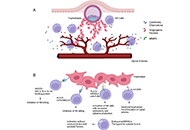 Natural killer cell-mediated immunopathology in recurrent pregnancy lossesOpen AccessReviewNatural killer (NK) cells have a dual role in human reproduction for maternal-fetal tolerance and protection from infection. During the ovarian cycle and pregnancy, peripheral NK (pNK) and uterine N...Thanh Luu ... Joanne Kwak-KimPublished: October 30, 2022 Explor Immunol. DOI: 10.37349/ei.2022.00077
Natural killer cell-mediated immunopathology in recurrent pregnancy lossesOpen AccessReviewNatural killer (NK) cells have a dual role in human reproduction for maternal-fetal tolerance and protection from infection. During the ovarian cycle and pregnancy, peripheral NK (pNK) and uterine N...Thanh Luu ... Joanne Kwak-KimPublished: October 30, 2022 Explor Immunol. DOI: 10.37349/ei.2022.00077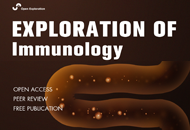 Utilization of formalin-fixed paraffin-embedded specimens for microbiota characterization in cancer: utility and concernOpen AccessPerspectiveMicrobiome research has enormous potential in cancer research and the use of formalin-fixed paraffin-embedded (FFPE) tissues could offer many advantages. The tumor microenvironment represents a suit...Leandro Di Gloria, Elena NiccolaiPublished: October 31, 2022 Explor Immunol. DOI: 10.37349/ei.2022.00078
Utilization of formalin-fixed paraffin-embedded specimens for microbiota characterization in cancer: utility and concernOpen AccessPerspectiveMicrobiome research has enormous potential in cancer research and the use of formalin-fixed paraffin-embedded (FFPE) tissues could offer many advantages. The tumor microenvironment represents a suit...Leandro Di Gloria, Elena NiccolaiPublished: October 31, 2022 Explor Immunol. DOI: 10.37349/ei.2022.00078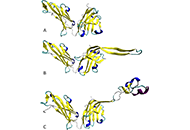 Fight fire with fire: the need for a vaccine based on intrinsic disorder and structural flexibilityOpen AccessReviewThe absence of advancement in finding efficient vaccines for several human viruses, such as hepatitis C virus (HCV), human immunodeficiency virus type 1 (HIV-1), and herpes simplex viruses (HSVs) de...Vladimir N. UverskyPublished: October 31, 2022 Explor Immunol. DOI: 10.37349/ei.2022.00079
Fight fire with fire: the need for a vaccine based on intrinsic disorder and structural flexibilityOpen AccessReviewThe absence of advancement in finding efficient vaccines for several human viruses, such as hepatitis C virus (HCV), human immunodeficiency virus type 1 (HIV-1), and herpes simplex viruses (HSVs) de...Vladimir N. UverskyPublished: October 31, 2022 Explor Immunol. DOI: 10.37349/ei.2022.00079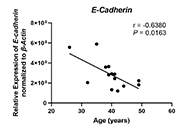 Do endometrial immune changes with age prior to menopause compromise fertility in women?Open AccessReviewMenopause signals the end of the reproductive period in women. However, fertility and fecundity decrease with increasing age prior to menopause demonstrating that changes in the premenopausal female...Mickey V. Patel ... Charles R. WiraPublished: October 29, 2022 Explor Immunol. DOI: 10.37349/ei.2022.00076
Do endometrial immune changes with age prior to menopause compromise fertility in women?Open AccessReviewMenopause signals the end of the reproductive period in women. However, fertility and fecundity decrease with increasing age prior to menopause demonstrating that changes in the premenopausal female...Mickey V. Patel ... Charles R. WiraPublished: October 29, 2022 Explor Immunol. DOI: 10.37349/ei.2022.00076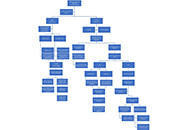 The progression of sepsis from physiologic systemic inflammatory response to immune dysregulation due to life-threatening infectionsOpen AccessReviewSepsis was defined in 1991 by the systemic inflammatory response syndrome (SIRS) criteria which consisted mostly of physiologic responses to infection or inflammation (fever, tachycardia, tachypnea,...Nicholas Daering, Majdi N. Al-HasanPublished: October 25, 2022 Explor Immunol. DOI: 10.37349/ei.2022.00075
The progression of sepsis from physiologic systemic inflammatory response to immune dysregulation due to life-threatening infectionsOpen AccessReviewSepsis was defined in 1991 by the systemic inflammatory response syndrome (SIRS) criteria which consisted mostly of physiologic responses to infection or inflammation (fever, tachycardia, tachypnea,...Nicholas Daering, Majdi N. Al-HasanPublished: October 25, 2022 Explor Immunol. DOI: 10.37349/ei.2022.00075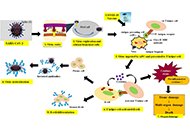 Immune responses to SARS-CoV-2 infection and COVID-19 vaccinesOpen AccessReviewCoronavirus disease 2019 (COVID-19) is currently a major public health concern causing devastating sociological, economic, and psychological damage to livelihood all over the world. The most intense...Basista Rabina Sharma, P. Veeranna RavindraPublished: September 21, 2022 Explor Immunol. DOI: 10.37349/ei.2022.00074
Immune responses to SARS-CoV-2 infection and COVID-19 vaccinesOpen AccessReviewCoronavirus disease 2019 (COVID-19) is currently a major public health concern causing devastating sociological, economic, and psychological damage to livelihood all over the world. The most intense...Basista Rabina Sharma, P. Veeranna RavindraPublished: September 21, 2022 Explor Immunol. DOI: 10.37349/ei.2022.00074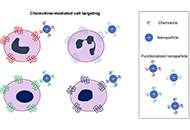 Chemokines and nanomaterials: interaction for useful immune-applicationsOpen AccessReviewChemokines are homeostatic or inflammatory small proteins regulating immune cell migration and are structurally characterized by cysteine disulfide bridges. Around 50 human chemokines binding almost...Giuseppe BardiPublished: August 31, 2022 Explor Immunol. DOI: 10.37349/ei.2022.00073
Chemokines and nanomaterials: interaction for useful immune-applicationsOpen AccessReviewChemokines are homeostatic or inflammatory small proteins regulating immune cell migration and are structurally characterized by cysteine disulfide bridges. Around 50 human chemokines binding almost...Giuseppe BardiPublished: August 31, 2022 Explor Immunol. DOI: 10.37349/ei.2022.00073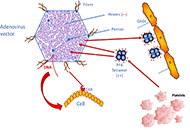 Vaccine induced thrombotic thrombocytopenia: development and reactivity of anti-platelet factor 4 antibodies and immune pathogenic mechanismsOpen AccessReviewIn ultrarare cases, patients vaccinated with DNA adenovirus vector vaccine against severe acute respiratory syndrome coronavirus-2 (SARS-CoV-2), develop a vaccine-induced immune thrombotic thrombocy...Jean Amiral ... Gwenaëlle RenaudPublished: August 31, 2022 Explor Immunol. DOI: 10.37349/ei.2022.00071
Vaccine induced thrombotic thrombocytopenia: development and reactivity of anti-platelet factor 4 antibodies and immune pathogenic mechanismsOpen AccessReviewIn ultrarare cases, patients vaccinated with DNA adenovirus vector vaccine against severe acute respiratory syndrome coronavirus-2 (SARS-CoV-2), develop a vaccine-induced immune thrombotic thrombocy...Jean Amiral ... Gwenaëlle RenaudPublished: August 31, 2022 Explor Immunol. DOI: 10.37349/ei.2022.00071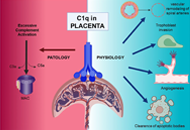 A non-redundant role of complement protein C1q in normal and adverse pregnancyOpen AccessReviewComplement component 1q (C1q) is the recognition molecule of the classical pathway of the complement system that can bind to an array of closely spaced antigen-bound immunoglobulin G (IgG) and IgM a...Chiara Agostinis ... Roberta BullaPublished: August 31, 2022 Explor Immunol. DOI: 10.37349/ei.2022.00072
A non-redundant role of complement protein C1q in normal and adverse pregnancyOpen AccessReviewComplement component 1q (C1q) is the recognition molecule of the classical pathway of the complement system that can bind to an array of closely spaced antigen-bound immunoglobulin G (IgG) and IgM a...Chiara Agostinis ... Roberta BullaPublished: August 31, 2022 Explor Immunol. DOI: 10.37349/ei.2022.00072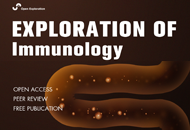 The human microbiome and the tumor microenvironmentOpen AccessPerspectiveThe human microbiome has emerged as an intriguing field of scientific research. Its role in human physiology impacts both health and disease, contributing to the enhancement or impairment of metabol...Joseph F. MurphyPublished: August 29, 2022 Explor Immunol. DOI: 10.37349/ei.2022.00069
The human microbiome and the tumor microenvironmentOpen AccessPerspectiveThe human microbiome has emerged as an intriguing field of scientific research. Its role in human physiology impacts both health and disease, contributing to the enhancement or impairment of metabol...Joseph F. MurphyPublished: August 29, 2022 Explor Immunol. DOI: 10.37349/ei.2022.00069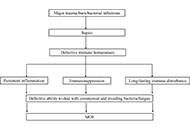 Understanding sepsis-induced immunosuppression and organ dysfunctions: from immunosuppression to immunotherapyOpen AccessReviewSepsis is a life-threatening condition caused by dysregulated host immune response to infection, leading to persistent inflammation followed by immunosuppression. Sepsis represents a substantial glo...Dablu Lal Gupta ... D. N. RaoPublished: August 29, 2022 Explor Immunol. DOI: 10.37349/ei.2022.00070
Understanding sepsis-induced immunosuppression and organ dysfunctions: from immunosuppression to immunotherapyOpen AccessReviewSepsis is a life-threatening condition caused by dysregulated host immune response to infection, leading to persistent inflammation followed by immunosuppression. Sepsis represents a substantial glo...Dablu Lal Gupta ... D. N. RaoPublished: August 29, 2022 Explor Immunol. DOI: 10.37349/ei.2022.00070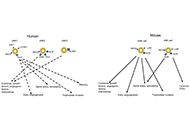 Uterine natural killer cells and successful pregnancy: from mouse experiments to human physiologyOpen AccessReviewUterine natural killer (uNK) cells, a specific type of natural killer (NK) cells, are important cells at the foeto-maternal interface in humans as well as in mice. uNK cells are part of the innate l...Marijke M. FaasPublished: August 25, 2022 Explor Immunol. DOI: 10.37349/ei.2022.00065
Uterine natural killer cells and successful pregnancy: from mouse experiments to human physiologyOpen AccessReviewUterine natural killer (uNK) cells, a specific type of natural killer (NK) cells, are important cells at the foeto-maternal interface in humans as well as in mice. uNK cells are part of the innate l...Marijke M. FaasPublished: August 25, 2022 Explor Immunol. DOI: 10.37349/ei.2022.00065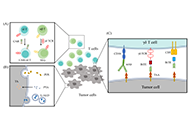 γδ T cells: a sparkling star for clinical immunotherapyOpen AccessReviewHuman γδ T cells are unconventional lymphocytes that function in innate and adaptive immune responses and immunosurveillance. These cells show potent cytotoxicity against tumor cells in a major histocompatibility complex unrestricted manner and have recently gained considerable attention as a sparkling star for clinical immunotherapy. Clinical immunotherapy trials with activated γδ T cells are tolerated well. However, clinical benefits are still unsatisfactory. Therefore, anti-tumor effects need to further increase the cytotoxicity of γδ T cells via several mechanisms, including the novel nitrogen-containing bisphosphonate products, adjuvant use with a bispecific antibody and chimeric antigen receptor, co-immunotherapy with γδ T cells plus immune checkpoint inhibitors, and adoptive immunotherapy with Vδ1 T cells and T cells engineered to express a defined γδ T cell receptor. Here, this article describes the crucial role of γδ T cells in anti-tumor immunity, concludes transduction strategies and summarizes the different development of novel approaches for clinical applications and cancer immunotherapy, which may be effective in overcoming current therapeutic limitations. ...Jiamian Zheng ... Zhenyi JinPublished: August 26, 2022 Explor Immunol. DOI: 10.37349/ei.2022.00066
γδ T cells: a sparkling star for clinical immunotherapyOpen AccessReviewHuman γδ T cells are unconventional lymphocytes that function in innate and adaptive immune responses and immunosurveillance. These cells show potent cytotoxicity against tumor cells in a major histocompatibility complex unrestricted manner and have recently gained considerable attention as a sparkling star for clinical immunotherapy. Clinical immunotherapy trials with activated γδ T cells are tolerated well. However, clinical benefits are still unsatisfactory. Therefore, anti-tumor effects need to further increase the cytotoxicity of γδ T cells via several mechanisms, including the novel nitrogen-containing bisphosphonate products, adjuvant use with a bispecific antibody and chimeric antigen receptor, co-immunotherapy with γδ T cells plus immune checkpoint inhibitors, and adoptive immunotherapy with Vδ1 T cells and T cells engineered to express a defined γδ T cell receptor. Here, this article describes the crucial role of γδ T cells in anti-tumor immunity, concludes transduction strategies and summarizes the different development of novel approaches for clinical applications and cancer immunotherapy, which may be effective in overcoming current therapeutic limitations. ...Jiamian Zheng ... Zhenyi JinPublished: August 26, 2022 Explor Immunol. DOI: 10.37349/ei.2022.00066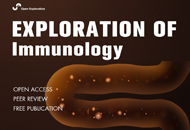 Contribution of immunology to build precision medicine in reproduction: present and futureOpen AccessReviewInfertility affects millions of people of reproductive age. The failure of a blastocyst to implant is a leading cause of psychological distress. It became increasingly evident that an effective immu...Alaa Kazhalawi ... Nathalie LédéePublished: August 26, 2022 Explor Immunol. DOI: 10.37349/ei.2022.00067
Contribution of immunology to build precision medicine in reproduction: present and futureOpen AccessReviewInfertility affects millions of people of reproductive age. The failure of a blastocyst to implant is a leading cause of psychological distress. It became increasingly evident that an effective immu...Alaa Kazhalawi ... Nathalie LédéePublished: August 26, 2022 Explor Immunol. DOI: 10.37349/ei.2022.00067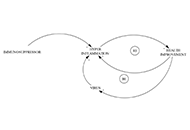 Immune network operations in COVID-19Open AccessPerspectiveThe immune system, whose nature lies in being a complex network of interactions, lends itself well to being represented and studied using graph theory. However, it should be noted that although the ...Javier Burgos-SalcedoPublished: August 26, 2022 Explor Immunol. DOI: 10.37349/ei.2022.00068
Immune network operations in COVID-19Open AccessPerspectiveThe immune system, whose nature lies in being a complex network of interactions, lends itself well to being represented and studied using graph theory. However, it should be noted that although the ...Javier Burgos-SalcedoPublished: August 26, 2022 Explor Immunol. DOI: 10.37349/ei.2022.00068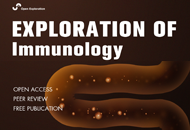 Pathogenesis of the obstetric antiphospholipid syndrome: the key role of beta 2 glycoprotein IOpen AccessReviewAntiphospholipid syndrome (APS) is defined by recurrent pregnancy morbidity and/or vascular thrombosis associated with the persistent presence of antibodies against anionic phospholipid-binding prot...Pier Luigi Meroni ... Francesco TedescoPublished: August 19, 2022 Explor Immunol. DOI: 10.37349/ei.2022.00064
Pathogenesis of the obstetric antiphospholipid syndrome: the key role of beta 2 glycoprotein IOpen AccessReviewAntiphospholipid syndrome (APS) is defined by recurrent pregnancy morbidity and/or vascular thrombosis associated with the persistent presence of antibodies against anionic phospholipid-binding prot...Pier Luigi Meroni ... Francesco TedescoPublished: August 19, 2022 Explor Immunol. DOI: 10.37349/ei.2022.00064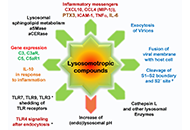 Small molecules targeting endolysosomal acidification and signaling in sepsis and severe SARS-CoV-2 infection/COVID-19Open AccessReviewSepsis and severe acute respiratory syndrome coronavirus 2 (SARS-CoV-2) infection, and its severe form coronavirus disease 2019 (COVID-19), represent the major medical challenges of the modern era. ...Markus Blaess ... Hans-Peter DeignerPublished: August 11, 2022 Explor Immunol. DOI: 10.37349/ei.2022.00063
Small molecules targeting endolysosomal acidification and signaling in sepsis and severe SARS-CoV-2 infection/COVID-19Open AccessReviewSepsis and severe acute respiratory syndrome coronavirus 2 (SARS-CoV-2) infection, and its severe form coronavirus disease 2019 (COVID-19), represent the major medical challenges of the modern era. ...Markus Blaess ... Hans-Peter DeignerPublished: August 11, 2022 Explor Immunol. DOI: 10.37349/ei.2022.00063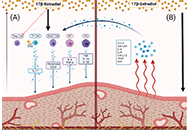 Endometriosis through an immunological lens: a pathophysiology based in immune dysregulationOpen AccessReviewEndometriosis (EMS) is an inflammatory, gynaecologic disease characterized by the growth of endometrial tissues outside the uterus. With no satisfactory therapies or non-invasive diagnostics availab...Alison McCallion ... Chandrakant TayadePublished: July 26, 2022 Explor Immunol. DOI: 10.37349/ei.2022.00062
Endometriosis through an immunological lens: a pathophysiology based in immune dysregulationOpen AccessReviewEndometriosis (EMS) is an inflammatory, gynaecologic disease characterized by the growth of endometrial tissues outside the uterus. With no satisfactory therapies or non-invasive diagnostics availab...Alison McCallion ... Chandrakant TayadePublished: July 26, 2022 Explor Immunol. DOI: 10.37349/ei.2022.00062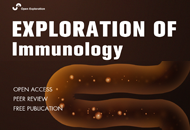 In COVID-19, antigen size lower or larger than 70 kDa modulates the sepsis and memory B cellsOpen AccessReviewThis review pretends to shed light on the immune processes occurring in the coronavirus disease 2019 (COVID-19) from a perspective based on the antigens size, lower or larger than 70 kDa. This cutof...Francisco Javier Martín OncinaPublished: July 17, 2022 Explor Immunol. DOI: 10.37349/ei.2022.00061
In COVID-19, antigen size lower or larger than 70 kDa modulates the sepsis and memory B cellsOpen AccessReviewThis review pretends to shed light on the immune processes occurring in the coronavirus disease 2019 (COVID-19) from a perspective based on the antigens size, lower or larger than 70 kDa. This cutof...Francisco Javier Martín OncinaPublished: July 17, 2022 Explor Immunol. DOI: 10.37349/ei.2022.00061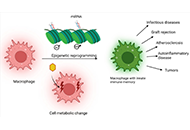 Advances in innate immune memory of macrophagesOpen AccessReviewImmunity is usually classified into two categories: innate immunity and adaptive immunity, distinguished by the process and characteristics of the immunological impact. It was widely assumed that on...Safir Ullah Khan, Munir Ullah KhanPublished: June 28, 2022 Explor Immunol. DOI: 10.37349/ei.2022.00060
Advances in innate immune memory of macrophagesOpen AccessReviewImmunity is usually classified into two categories: innate immunity and adaptive immunity, distinguished by the process and characteristics of the immunological impact. It was widely assumed that on...Safir Ullah Khan, Munir Ullah KhanPublished: June 28, 2022 Explor Immunol. DOI: 10.37349/ei.2022.00060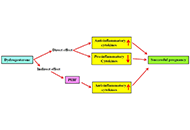 Cytokines and pregnancy complications: modulation for prevention and treatmentOpen AccessReview“There is many a slip twist the cup and the lip” is a proverb that dates back to the 3rd century. This proverb comes to mind while writing a review on pregnancy loss; so many complications can occur between fertilization and development of the embryo through the long period of gestation until successful delivery of the baby. These include failure of implantation of the embryo, spontaneous miscarriage in the first trimester, pre-eclampsia in the second trimester, premature rupture of fetal membranes, pre-term labour, and pre-term delivery. The maternal immune system which does a phenomenal job of protecting the host from a daunting variety of infections, sometimes also mounts adverse reactions that complicate pregnancy and endanger the fetus. Maternal immune reactions that can adversely affect pregnancy have been shown to be mediated by lymphocytes, macrophages and natural killer cells, and by cytokines secreted by these cellular effectors. This review summarizes the deleterious effects of cytokines leading to recurrent spontaneous miscarriage, pre-eclampsia and pre-term delivery, which are the major complications of pregnancy. It then goes on to discuss the potential use of progesterone and dydrogesterone, an orally-administered progestogen, as immunomodulatory molecules that can be considered for the prevention and/or treatment of these complications....Raj RaghupathyPublished: June 27, 2022 Explor Immunol. DOI: 10.37349/ei.2022.00059
Cytokines and pregnancy complications: modulation for prevention and treatmentOpen AccessReview“There is many a slip twist the cup and the lip” is a proverb that dates back to the 3rd century. This proverb comes to mind while writing a review on pregnancy loss; so many complications can occur between fertilization and development of the embryo through the long period of gestation until successful delivery of the baby. These include failure of implantation of the embryo, spontaneous miscarriage in the first trimester, pre-eclampsia in the second trimester, premature rupture of fetal membranes, pre-term labour, and pre-term delivery. The maternal immune system which does a phenomenal job of protecting the host from a daunting variety of infections, sometimes also mounts adverse reactions that complicate pregnancy and endanger the fetus. Maternal immune reactions that can adversely affect pregnancy have been shown to be mediated by lymphocytes, macrophages and natural killer cells, and by cytokines secreted by these cellular effectors. This review summarizes the deleterious effects of cytokines leading to recurrent spontaneous miscarriage, pre-eclampsia and pre-term delivery, which are the major complications of pregnancy. It then goes on to discuss the potential use of progesterone and dydrogesterone, an orally-administered progestogen, as immunomodulatory molecules that can be considered for the prevention and/or treatment of these complications....Raj RaghupathyPublished: June 27, 2022 Explor Immunol. DOI: 10.37349/ei.2022.00059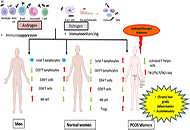 Polycystic ovary syndrome and immune deregulation: what do hormones want to say?Open AccessReviewPolycystic ovary syndrome (PCOS) is one of the most frequently observed endocrinopathies among women of reproductive age that redound to subfertility. The specific etiology of this heterogenic syndr...Betcy Susan Johnson, Malini LalorayaPublished: June 27, 2022 Explor Immunol. DOI: 10.37349/ei.2022.00058
Polycystic ovary syndrome and immune deregulation: what do hormones want to say?Open AccessReviewPolycystic ovary syndrome (PCOS) is one of the most frequently observed endocrinopathies among women of reproductive age that redound to subfertility. The specific etiology of this heterogenic syndr...Betcy Susan Johnson, Malini LalorayaPublished: June 27, 2022 Explor Immunol. DOI: 10.37349/ei.2022.00058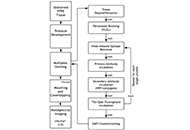 A multispectral immunohistochemistry panel to investigate γδ T cells and butyrophilin molecules in the tumour microenvironmentOpen AccessProtocolConventional immunohistochemistry methods though once fundamental for the individual staining of cell markers, have now been superseded by multispectral immunohistochemistry (mIHC). mIHC enables sim...Jessica Da Gama Duarte ... Andreas BehrenPublished: June 16, 2022 Explor Immunol. DOI: 10.37349/ei.2022.00057
A multispectral immunohistochemistry panel to investigate γδ T cells and butyrophilin molecules in the tumour microenvironmentOpen AccessProtocolConventional immunohistochemistry methods though once fundamental for the individual staining of cell markers, have now been superseded by multispectral immunohistochemistry (mIHC). mIHC enables sim...Jessica Da Gama Duarte ... Andreas BehrenPublished: June 16, 2022 Explor Immunol. DOI: 10.37349/ei.2022.00057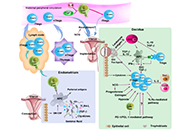 Inviting regulatory T cells to pregnant endometrium: friends or foes in adverse pregnancy outcomes?Open AccessReviewAmong decidual immune cells, regulatory T cells (Tregs) have been unanimously recognized as central contributors to tolerance and maintenance of healthy pregnancy. Numerical and functional downregul...Shibin Cheng ... Surendra SharmaPublished: June 13, 2022 Explor Immunol. DOI: 10.37349/ei.2022.00056
Inviting regulatory T cells to pregnant endometrium: friends or foes in adverse pregnancy outcomes?Open AccessReviewAmong decidual immune cells, regulatory T cells (Tregs) have been unanimously recognized as central contributors to tolerance and maintenance of healthy pregnancy. Numerical and functional downregul...Shibin Cheng ... Surendra SharmaPublished: June 13, 2022 Explor Immunol. DOI: 10.37349/ei.2022.00056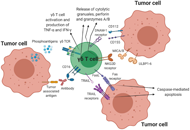 Allogeneic gamma delta T cells as adoptive cellular therapy for hematologic malignanciesOpen AccessReviewCancer immunotherapy, especially T-cell driven targeting, has significantly evolved and improved over the past decade, paving the way to treat previously refractory cancers. Hematologic malignancies...Navdeep Jhita, Sunil S. RaikarPublished: June 07, 2022 Explor Immunol. DOI: 10.37349/ei.2022.00054
Allogeneic gamma delta T cells as adoptive cellular therapy for hematologic malignanciesOpen AccessReviewCancer immunotherapy, especially T-cell driven targeting, has significantly evolved and improved over the past decade, paving the way to treat previously refractory cancers. Hematologic malignancies...Navdeep Jhita, Sunil S. RaikarPublished: June 07, 2022 Explor Immunol. DOI: 10.37349/ei.2022.00054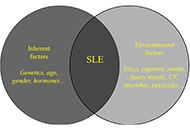 The influence of reproductive hormones on systemic lupus erythematosusOpen AccessReviewHumans are afflicted by a wide spectrum of autoimmune disorders, ranging from those affecting just one or a few organs to those associated with more systemic effects. In most instances, the etiology...Ruchi Sachdeva, Rahul PalPublished: June 07, 2022 Explor Immunol. DOI: 10.37349/ei.2022.00055
The influence of reproductive hormones on systemic lupus erythematosusOpen AccessReviewHumans are afflicted by a wide spectrum of autoimmune disorders, ranging from those affecting just one or a few organs to those associated with more systemic effects. In most instances, the etiology...Ruchi Sachdeva, Rahul PalPublished: June 07, 2022 Explor Immunol. DOI: 10.37349/ei.2022.00055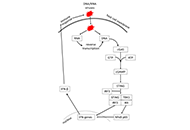 Sensing of viral lung infections by cGAS-STINGOpen AccessReviewLower respiratory tract infections caused over 4 million deaths per year worldwide, especially in low-income countries. Viral respiratory infections often occur as rapidly spreading seasonal endemic...Lei Fang, Michael RothPublished: May 30, 2022 Explor Immunol. DOI: 10.37349/ei.2022.00052
Sensing of viral lung infections by cGAS-STINGOpen AccessReviewLower respiratory tract infections caused over 4 million deaths per year worldwide, especially in low-income countries. Viral respiratory infections often occur as rapidly spreading seasonal endemic...Lei Fang, Michael RothPublished: May 30, 2022 Explor Immunol. DOI: 10.37349/ei.2022.00052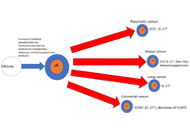 Obesity and cancer: the gammadelta T cell linkOpen AccessReviewObesity has become a worldwide scourge, affecting more than 10% of adults worldwide. While widely recognized to be associated with increased incidence of medical conditions such as diabe...Ilan BankPublished: May 31, 2022 Explor Immunol. DOI: 10.37349/ei.2022.00053
Obesity and cancer: the gammadelta T cell linkOpen AccessReviewObesity has become a worldwide scourge, affecting more than 10% of adults worldwide. While widely recognized to be associated with increased incidence of medical conditions such as diabe...Ilan BankPublished: May 31, 2022 Explor Immunol. DOI: 10.37349/ei.2022.00053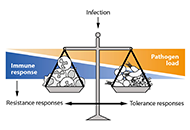 Janus face of sepsis: a viewpointOpen AccessReviewTreatment of sepsis currently relies on eliminating the causal pathogen and supportive care, whereas almost no approaches to interfere with the defining event of a “dysregulated host response” are available. This review points to the striking correlation of two phenotypes of sepsis etiopathology with the concept of bipartite response patterns of higher organisms to microbial attacks. According to this concept, the phenotypes of sepsis can be interpreted as either resistance or tolerance responses to infection that got out of hand. This concept might allow focusing sepsis research and related patient studies on key conundrums of current sepsis research: how do resistance responses result in immunopathology and how can tolerance lead to systemic immunosuppression or even immunoparalysis? The heuristic vigor of these questions might inspire experimental efforts and clinical studies and ultimately advance the therapeutic armamentarium for sepsis care....Michael Bauer, Reinhard WetzkerPublished: May 24, 2022 Explor Immunol. DOI: 10.37349/ei.2022.00051
Janus face of sepsis: a viewpointOpen AccessReviewTreatment of sepsis currently relies on eliminating the causal pathogen and supportive care, whereas almost no approaches to interfere with the defining event of a “dysregulated host response” are available. This review points to the striking correlation of two phenotypes of sepsis etiopathology with the concept of bipartite response patterns of higher organisms to microbial attacks. According to this concept, the phenotypes of sepsis can be interpreted as either resistance or tolerance responses to infection that got out of hand. This concept might allow focusing sepsis research and related patient studies on key conundrums of current sepsis research: how do resistance responses result in immunopathology and how can tolerance lead to systemic immunosuppression or even immunoparalysis? The heuristic vigor of these questions might inspire experimental efforts and clinical studies and ultimately advance the therapeutic armamentarium for sepsis care....Michael Bauer, Reinhard WetzkerPublished: May 24, 2022 Explor Immunol. DOI: 10.37349/ei.2022.00051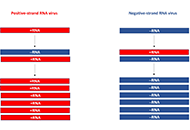 Therapeutic and prophylactic applications of self-replicating RNA virusesOpen AccessReviewSelf-replicating RNA viruses have been commonly used for preventive and therapeutic interventions in the fields of infectious diseases and cancers. Both RNA viruses with single-stranded RNA genomes ...Kenneth LundstromPublished: May 18, 2022 Explor Immunol. DOI: 10.37349/ei.2022.00050
Therapeutic and prophylactic applications of self-replicating RNA virusesOpen AccessReviewSelf-replicating RNA viruses have been commonly used for preventive and therapeutic interventions in the fields of infectious diseases and cancers. Both RNA viruses with single-stranded RNA genomes ...Kenneth LundstromPublished: May 18, 2022 Explor Immunol. DOI: 10.37349/ei.2022.00050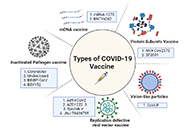 SARS-CoV-2: overview of immune response, insights into vaccine platforms and their challengesOpen AccessReviewThe crown-like shaped viruses known as coronaviruses which were first reported in the 1960’s have caused three epidemics in the past two decades namely, coronavirus disease-19 (COVID-19), severe acute respiratory syndrome (SARS), and Middle East respiratory syndrome (MERS). SARS coronavirus 2 (SARS-CoV-2) was first reported in the latter half of December in Wuhan, a city of China, with people affected by deadly pneumonia with unknown etiology. Since then, the world has experienced two phases of virus spread with different symptoms and disease severity. This review embarks on the journey to investigate candidate molecules of this virus which can and are being investigated for various vaccine formulations and to discuss immunity developed against this virus....Balram Ji Omar ... Manju O. PaiPublished: May 16, 2022 Explor Immunol. DOI: 10.37349/ei.2022.00049
SARS-CoV-2: overview of immune response, insights into vaccine platforms and their challengesOpen AccessReviewThe crown-like shaped viruses known as coronaviruses which were first reported in the 1960’s have caused three epidemics in the past two decades namely, coronavirus disease-19 (COVID-19), severe acute respiratory syndrome (SARS), and Middle East respiratory syndrome (MERS). SARS coronavirus 2 (SARS-CoV-2) was first reported in the latter half of December in Wuhan, a city of China, with people affected by deadly pneumonia with unknown etiology. Since then, the world has experienced two phases of virus spread with different symptoms and disease severity. This review embarks on the journey to investigate candidate molecules of this virus which can and are being investigated for various vaccine formulations and to discuss immunity developed against this virus....Balram Ji Omar ... Manju O. PaiPublished: May 16, 2022 Explor Immunol. DOI: 10.37349/ei.2022.00049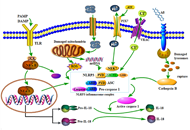 Mechanism of NLRP3 inflammasome activation and its role in Alzheimer’s diseaseOpen AccessReviewAlzheimer’s disease (AD) is a common neurological disease in the elderly, and the major manifestations are cognitive dysfunction, neuronal loss, and neuropathic lesions in the brain. In ...Xiaohan Gao ... Xueling DaiPublished: May 07, 2022 Explor Immunol. DOI: 10.37349/ei.2022.00048
Mechanism of NLRP3 inflammasome activation and its role in Alzheimer’s diseaseOpen AccessReviewAlzheimer’s disease (AD) is a common neurological disease in the elderly, and the major manifestations are cognitive dysfunction, neuronal loss, and neuropathic lesions in the brain. In ...Xiaohan Gao ... Xueling DaiPublished: May 07, 2022 Explor Immunol. DOI: 10.37349/ei.2022.00048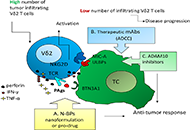 Anti-cancer γδ T lymphocytes: contradictory past and promising futureOpen AccessPerspectiveRecent anti-cancer strategies are based on the stimulation of anti-tumor immune reaction, exploiting distinct lymphocyte subsets. Among them, γδ T cells represent optimal anti-cancer candidates, especially in those tissues where they are highly localized, such as the respiratory or gastrointestinal tract. One important challenge has been the identification of stimulating drugs able to induce and maintain γδ T cell-mediated anti-cancer immune response. Amino-bisphosphonates (N-BPs) have been largely employed in anti-cancer clinical trials due to their ability to upregulate the accumulation of pyrophosphates that promote the activation of Vγ9Vδ2 T cells. This activation depends on the butyrophilin A family, which is crucial in contributing to Vγ9Vδ2 T cells stimulation but is not equally expressed in all cancer tissues. Thus, the clinical outcome of such treatments is still a challenge. In this viewpoint, a critical picture of γδ T cells as effective anti-cancer effectors is designed, with a specific focus on the best immune-stimulating therapeutic schemes involving this lymphocyte subset and the tools available to measure their efficacy and presence in tumor tissues. Some pre-clinical models, useful to measure γδ T cell anti-cancer potential and their response to stimulating drugs, therapeutic monoclonal antibodies, or bispecific antibodies are described. Computerized imaging and digital pathology are also proposed as a help in the identification of co-stimulatory molecules and localization of γδ T cell effectors. Finally, two types of novel drug preparation are proposed: nanoparticles loaded with N-BPs and pro-drug formulations that enhance the effectiveness of γδ T lymphocyte stimulation....Alessandro Poggi, Maria Raffaella ZocchiPublished: April 28, 2022 Explor Immunol. DOI: 10.37349/ei.2022.00047
Anti-cancer γδ T lymphocytes: contradictory past and promising futureOpen AccessPerspectiveRecent anti-cancer strategies are based on the stimulation of anti-tumor immune reaction, exploiting distinct lymphocyte subsets. Among them, γδ T cells represent optimal anti-cancer candidates, especially in those tissues where they are highly localized, such as the respiratory or gastrointestinal tract. One important challenge has been the identification of stimulating drugs able to induce and maintain γδ T cell-mediated anti-cancer immune response. Amino-bisphosphonates (N-BPs) have been largely employed in anti-cancer clinical trials due to their ability to upregulate the accumulation of pyrophosphates that promote the activation of Vγ9Vδ2 T cells. This activation depends on the butyrophilin A family, which is crucial in contributing to Vγ9Vδ2 T cells stimulation but is not equally expressed in all cancer tissues. Thus, the clinical outcome of such treatments is still a challenge. In this viewpoint, a critical picture of γδ T cells as effective anti-cancer effectors is designed, with a specific focus on the best immune-stimulating therapeutic schemes involving this lymphocyte subset and the tools available to measure their efficacy and presence in tumor tissues. Some pre-clinical models, useful to measure γδ T cell anti-cancer potential and their response to stimulating drugs, therapeutic monoclonal antibodies, or bispecific antibodies are described. Computerized imaging and digital pathology are also proposed as a help in the identification of co-stimulatory molecules and localization of γδ T cell effectors. Finally, two types of novel drug preparation are proposed: nanoparticles loaded with N-BPs and pro-drug formulations that enhance the effectiveness of γδ T lymphocyte stimulation....Alessandro Poggi, Maria Raffaella ZocchiPublished: April 28, 2022 Explor Immunol. DOI: 10.37349/ei.2022.00047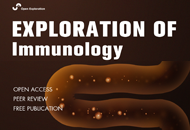 A proposed new paradigm for an anti-AIDS tolerogenic vaccineOpen AccessReviewUntil now, despite 30 years of intensive work, the RV144 human immunodeficiency virus (HIV) vaccine trial initiated in 2003 remains so far the most protective vaccine prototype of all those tested (...Christine JacometPublished: April 24, 2022 Explor Immunol. DOI: 10.37349/ei.2022.00046
A proposed new paradigm for an anti-AIDS tolerogenic vaccineOpen AccessReviewUntil now, despite 30 years of intensive work, the RV144 human immunodeficiency virus (HIV) vaccine trial initiated in 2003 remains so far the most protective vaccine prototype of all those tested (...Christine JacometPublished: April 24, 2022 Explor Immunol. DOI: 10.37349/ei.2022.00046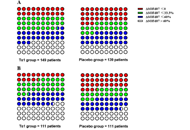 Thymosin alpha 1 therapy alleviates organ dysfunction of sepsis patients: a retrospective cohort studyOpen AccessOriginal ArticleAim: Thymosin alpha 1 (Tα1) is a promising treatment for the improvement of sepsis patients. Until now, its function in reducing acute organ damage of sepsis patients is still unclear. The aim of this study was to determine whether Tα1 can alleviate organ dysfunction in sepsis patients....Fei Pei ... on behalf of the China Critical Care Immunotherapy Research GroupPublished: April 22, 2022 Explor Immunol. DOI: 10.37349/ei.2022.00045
Thymosin alpha 1 therapy alleviates organ dysfunction of sepsis patients: a retrospective cohort studyOpen AccessOriginal ArticleAim: Thymosin alpha 1 (Tα1) is a promising treatment for the improvement of sepsis patients. Until now, its function in reducing acute organ damage of sepsis patients is still unclear. The aim of this study was to determine whether Tα1 can alleviate organ dysfunction in sepsis patients....Fei Pei ... on behalf of the China Critical Care Immunotherapy Research GroupPublished: April 22, 2022 Explor Immunol. DOI: 10.37349/ei.2022.00045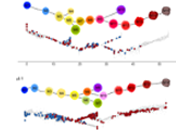 Single-cell differentiation trajectories define early stages of a human cutaneous T-cell lymphomaOpen AccessOriginal ArticleAim: The aim of this article is to characterize in detail the γδ T lymphocytes from an adult patient with primary cutaneous T-cell lymphoma of γδ s...Juan-Pablo Cerapio ... Jean-Jacques FourniePublished: April 15, 2022 Explor Immunol. DOI: 10.37349/ei.2022.00044
Single-cell differentiation trajectories define early stages of a human cutaneous T-cell lymphomaOpen AccessOriginal ArticleAim: The aim of this article is to characterize in detail the γδ T lymphocytes from an adult patient with primary cutaneous T-cell lymphoma of γδ s...Juan-Pablo Cerapio ... Jean-Jacques FourniePublished: April 15, 2022 Explor Immunol. DOI: 10.37349/ei.2022.00044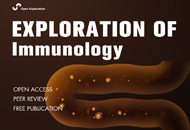 Paradigms in HIV vaccine researchOpen AccessReviewAlthough a large number of preventative human immunodeficiency virus (HIV) vaccine trials have been carried out during the last 30 years, it is remarkable that an effective HIV vaccine has not yet b...Marc H.V. Van RegenmortelPublished: March 17, 2022 Explor Immunol. DOI: 10.37349/ei.2022.00043
Paradigms in HIV vaccine researchOpen AccessReviewAlthough a large number of preventative human immunodeficiency virus (HIV) vaccine trials have been carried out during the last 30 years, it is remarkable that an effective HIV vaccine has not yet b...Marc H.V. Van RegenmortelPublished: March 17, 2022 Explor Immunol. DOI: 10.37349/ei.2022.00043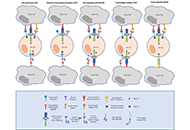 Augmenting human gamma delta lymphocytes for cancer therapy with chimeric antigen receptorsOpen AccessReviewGamma delta lymphocytes (γδ T) sit at the interface between innate and adaptive immunity. They have the capacity to recognize cancer cells by interaction of their surface receptors with an array of cancer cell surface target antigens. Interactions include the binding of γδ T cell receptors, the ligands for which are diverse and do not involve classical major histocompatibility complex (MHC) molecules. Moreover, a variety of natural killer-like and fragment crystallizable gamma (Fcγ) receptors confer additional cancer reactivity. Given this innate capacity to recognize and kill cancer cells, there appears less rationale for redirecting specific to cancer cell surface antigens through chimeric antigen receptor (CAR) expression. Several groups have however reported research findings that expression of CARs in γδ T cells can confer additional specificity or functionality. Though limited in number, these studies collectively identify the potential of CAR-T engineering to augment and fine tune anti-cancer responses. Together with the lack of graft versus host disease induced by allogeneic γδ T cells, these insights should encourage researchers to explore additional γδ T-CAR refinements for the development of off-the-shelf anti-cancer cell therapies. ...Gabrielle M. Ferry, John AndersonPublished: March 17, 2022 Explor Immunol. DOI: 10.37349/ei.2022.00042
Augmenting human gamma delta lymphocytes for cancer therapy with chimeric antigen receptorsOpen AccessReviewGamma delta lymphocytes (γδ T) sit at the interface between innate and adaptive immunity. They have the capacity to recognize cancer cells by interaction of their surface receptors with an array of cancer cell surface target antigens. Interactions include the binding of γδ T cell receptors, the ligands for which are diverse and do not involve classical major histocompatibility complex (MHC) molecules. Moreover, a variety of natural killer-like and fragment crystallizable gamma (Fcγ) receptors confer additional cancer reactivity. Given this innate capacity to recognize and kill cancer cells, there appears less rationale for redirecting specific to cancer cell surface antigens through chimeric antigen receptor (CAR) expression. Several groups have however reported research findings that expression of CARs in γδ T cells can confer additional specificity or functionality. Though limited in number, these studies collectively identify the potential of CAR-T engineering to augment and fine tune anti-cancer responses. Together with the lack of graft versus host disease induced by allogeneic γδ T cells, these insights should encourage researchers to explore additional γδ T-CAR refinements for the development of off-the-shelf anti-cancer cell therapies. ...Gabrielle M. Ferry, John AndersonPublished: March 17, 2022 Explor Immunol. DOI: 10.37349/ei.2022.00042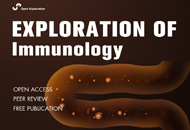 High avidity of vaccine-induced immunoglobulin G against SARS-CoV-2: potential relevance for protective humoral immunityOpen AccessReviewAvidity of immunoglobulin G (IgG) is defined as its binding strength to its target antigen. As a consequence of affinity maturation of the IgG response, avidity is maturing as well. Therefore, acute...Georg BauerPublished: March 16, 2022 Explor Immunol. DOI: 10.37349/ei.2022.00040
High avidity of vaccine-induced immunoglobulin G against SARS-CoV-2: potential relevance for protective humoral immunityOpen AccessReviewAvidity of immunoglobulin G (IgG) is defined as its binding strength to its target antigen. As a consequence of affinity maturation of the IgG response, avidity is maturing as well. Therefore, acute...Georg BauerPublished: March 16, 2022 Explor Immunol. DOI: 10.37349/ei.2022.00040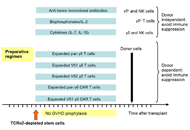 The role of γδ T cells in the context of allogeneic stem cell transplantationOpen AccessReviewAllogeneic stem cell transplantation is currently the only curative approach for a variety of malignant and non-malignant diseases. In the early transplant era, the intent of this treatment was to a...Rupert Handgretinger ... Manon QueudevillePublished: March 16, 2022 Explor Immunol. DOI: 10.37349/ei.2022.00041
The role of γδ T cells in the context of allogeneic stem cell transplantationOpen AccessReviewAllogeneic stem cell transplantation is currently the only curative approach for a variety of malignant and non-malignant diseases. In the early transplant era, the intent of this treatment was to a...Rupert Handgretinger ... Manon QueudevillePublished: March 16, 2022 Explor Immunol. DOI: 10.37349/ei.2022.00041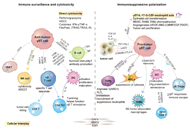 Novel insights based on the plasticity of γδ T cells in the tumor microenvironmentOpen AccessReviewγδ T cells express unique T cell receptor (TCR) γ and TCR δ chains, with structural and functional heterogeneity. Taking advantage of the diverse γδ TCR repertoire or other ligand-receptor interactions, γδ T cells can recognize a broad spectrum of tumor-associated antigens (TAAs) in a major histocompatibility complex (MHC)-independent manner,...Yue Wang ... Wei HePublished: February 24, 2022 Explor Immunol. DOI: 10.37349/ei.2022.00039
Novel insights based on the plasticity of γδ T cells in the tumor microenvironmentOpen AccessReviewγδ T cells express unique T cell receptor (TCR) γ and TCR δ chains, with structural and functional heterogeneity. Taking advantage of the diverse γδ TCR repertoire or other ligand-receptor interactions, γδ T cells can recognize a broad spectrum of tumor-associated antigens (TAAs) in a major histocompatibility complex (MHC)-independent manner,...Yue Wang ... Wei HePublished: February 24, 2022 Explor Immunol. DOI: 10.37349/ei.2022.00039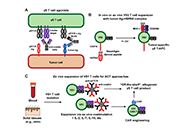 γδ T cell costimulatory ligands in antitumor immunityOpen AccessReviewAntitumor immunity relies on the ability of T cells to recognize and kill tumor targets. γδ T cells are a specialized subset of T cells that predominantly localizes to non-ly...Joseph M. McGraw, Deborah A. WitherdenPublished: February 24, 2022 Explor Immunol. DOI: 10.37349/ei.2022.00038
γδ T cell costimulatory ligands in antitumor immunityOpen AccessReviewAntitumor immunity relies on the ability of T cells to recognize and kill tumor targets. γδ T cells are a specialized subset of T cells that predominantly localizes to non-ly...Joseph M. McGraw, Deborah A. WitherdenPublished: February 24, 2022 Explor Immunol. DOI: 10.37349/ei.2022.00038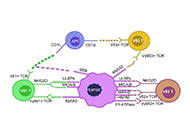 Tumor-associated protein ligands recognized by human γδ T cell receptor and their implications in cancer therapyOpen AccessReviewIn recent years, immunologists have been working to utilize the functional mechanism of the immune system to research new tumor treatment methods and achieved a major breakthrough in 2013, which was...Chang Liu ... Wei HePublished: February 22, 2022 Explor Immunol. DOI: 10.37349/ei.2022.00037
Tumor-associated protein ligands recognized by human γδ T cell receptor and their implications in cancer therapyOpen AccessReviewIn recent years, immunologists have been working to utilize the functional mechanism of the immune system to research new tumor treatment methods and achieved a major breakthrough in 2013, which was...Chang Liu ... Wei HePublished: February 22, 2022 Explor Immunol. DOI: 10.37349/ei.2022.00037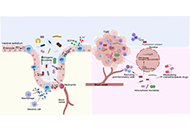 The microbiota is a potential mediator of the crosstalk between γδ T cells and tumorsOpen AccessReviewγδ T cells are one of the immune cell types that express antigen receptors. γδ T cells are able to recognize pathogens or cancer cells independently o...Huidi Wang ... Jia YinPublished: February 18, 2022 Explor Immunol. DOI: 10.37349/ei.2022.00036
The microbiota is a potential mediator of the crosstalk between γδ T cells and tumorsOpen AccessReviewγδ T cells are one of the immune cell types that express antigen receptors. γδ T cells are able to recognize pathogens or cancer cells independently o...Huidi Wang ... Jia YinPublished: February 18, 2022 Explor Immunol. DOI: 10.37349/ei.2022.00036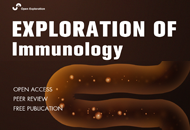 Endometriosis and autoimmunityOpen AccessPerspectiveEndometriosis is an inflammatory oestrogen-dependent chronic disease and is mainly expressed by pain and increased infertility. Several studies showed an increased prevalence of autoimmune systemic ...Noémie Abisror ... Arsene MekinianPublished: February 16, 2022 Explor Immunol. DOI: 10.37349/ei.2022.00034
Endometriosis and autoimmunityOpen AccessPerspectiveEndometriosis is an inflammatory oestrogen-dependent chronic disease and is mainly expressed by pain and increased infertility. Several studies showed an increased prevalence of autoimmune systemic ...Noémie Abisror ... Arsene MekinianPublished: February 16, 2022 Explor Immunol. DOI: 10.37349/ei.2022.00034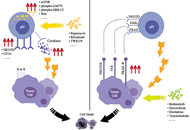 γδT cells: alternative treasure in antitumor immunityOpen AccessReviewIn recent decades, abundant methods for targeted tumor cell immunotherapy have been developed. It was recently discovered that excellent curative effects observed in hematological tumors cannot be achieved in solid tumors, as serious side effects will occur....Xiangjin Zhang ... Wei HePublished: February 17, 2022 Explor Immunol. DOI: 10.37349/ei.2022.00035
γδT cells: alternative treasure in antitumor immunityOpen AccessReviewIn recent decades, abundant methods for targeted tumor cell immunotherapy have been developed. It was recently discovered that excellent curative effects observed in hematological tumors cannot be achieved in solid tumors, as serious side effects will occur....Xiangjin Zhang ... Wei HePublished: February 17, 2022 Explor Immunol. DOI: 10.37349/ei.2022.00035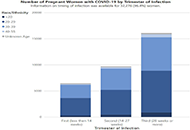 Fertility and COVID-19 vaccinationOpen AccessPerspectiveOne of the most troubling developments of 2021 has been the number of fertile-age women who have been led to believe that mRNA vaccines against severe acute respiratory syndrome coronavirus-2 [SARS-CoV-2, coronavirus disease 2019 (COVID-19)] can cause infertility via cross-reactivity of immune response. Specifically, cross-reactivity of developed antibodies to syncytin-1, a protein found in human cell fusion, placentation and recently identified in the envelope gene of a human endogenous defective retrovirus, HERV-W (see “Syncytin is a captive retroviral envelope protein involved in human placental morphogenesis”. Nature.2000;403:785–9. doi: 10.1038/35001608). The mechanism, evidence, and evaluation of the claim is presented concluding in a rejection due to lack of evidence....Iosif M. GershteynPublished: February 11, 2022 Explor Immunol. DOI: 10.37349/ei.2022.00032
Fertility and COVID-19 vaccinationOpen AccessPerspectiveOne of the most troubling developments of 2021 has been the number of fertile-age women who have been led to believe that mRNA vaccines against severe acute respiratory syndrome coronavirus-2 [SARS-CoV-2, coronavirus disease 2019 (COVID-19)] can cause infertility via cross-reactivity of immune response. Specifically, cross-reactivity of developed antibodies to syncytin-1, a protein found in human cell fusion, placentation and recently identified in the envelope gene of a human endogenous defective retrovirus, HERV-W (see “Syncytin is a captive retroviral envelope protein involved in human placental morphogenesis”. Nature.2000;403:785–9. doi: 10.1038/35001608). The mechanism, evidence, and evaluation of the claim is presented concluding in a rejection due to lack of evidence....Iosif M. GershteynPublished: February 11, 2022 Explor Immunol. DOI: 10.37349/ei.2022.00032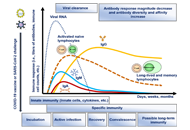 Immune titers of protection against severe acute respiratory syndrome coronavirus 2: are we there yet?Open AccessReviewA few pieces of research exist about the protective titer against severe acute respiratory syndrome (SARS) coronavirus 2 (CoV-2; SARS-CoV-2) in monkeys and humans in which the protection could be sh...Yoanna Slabakova ... Tsvetelina VelikovaPublished: February 11, 2022 Explor Immunol. DOI: 10.37349/ei.2022.00033
Immune titers of protection against severe acute respiratory syndrome coronavirus 2: are we there yet?Open AccessReviewA few pieces of research exist about the protective titer against severe acute respiratory syndrome (SARS) coronavirus 2 (CoV-2; SARS-CoV-2) in monkeys and humans in which the protection could be sh...Yoanna Slabakova ... Tsvetelina VelikovaPublished: February 11, 2022 Explor Immunol. DOI: 10.37349/ei.2022.00033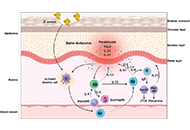 Crosstalk between keratinocytes and immune cells in inflammatory skin diseasesOpen AccessReviewCutaneous homeostasis is maintained by dynamic cellular communications between different cell types in the skin through interactions with various mediators, including cytokines, chemokines and antim...Xinhui Ni, Yuping LaiPublished: December 31, 2021 Explor Immunol. DOI: 10.37349/ei.2021.00028
Crosstalk between keratinocytes and immune cells in inflammatory skin diseasesOpen AccessReviewCutaneous homeostasis is maintained by dynamic cellular communications between different cell types in the skin through interactions with various mediators, including cytokines, chemokines and antim...Xinhui Ni, Yuping LaiPublished: December 31, 2021 Explor Immunol. DOI: 10.37349/ei.2021.00028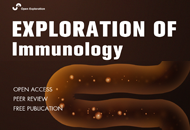 New variants of SARS-CoV-2, vaccine immune response and the Brazilian realityOpen AccessReviewSevere acute respiratory syndrome coronavirus 2 (SARS-CoV-2), a highly pathogenic β-coronavirus, is the etiologic agent of coronavirus disease 2019 (COVID-19), which gave rise to a diffi...Marileia Chaves Andrade ... Hellen Oliveira RosaPublished: December 31, 2021 Explor Immunol. DOI: 10.37349/ei.2021.00029
New variants of SARS-CoV-2, vaccine immune response and the Brazilian realityOpen AccessReviewSevere acute respiratory syndrome coronavirus 2 (SARS-CoV-2), a highly pathogenic β-coronavirus, is the etiologic agent of coronavirus disease 2019 (COVID-19), which gave rise to a diffi...Marileia Chaves Andrade ... Hellen Oliveira RosaPublished: December 31, 2021 Explor Immunol. DOI: 10.37349/ei.2021.00029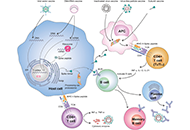 State-of-the-art preclinical evaluation of COVID-19 vaccine candidatesOpen AccessReviewThe coronavirus disease 2019 (COVID-19) results from the infection of severe acute respiratory syndrome coronavirus-2 (SARS-CoV-2) and primarily affects the respiratory tissue. Since first reported ...Devlina Ghosh ... Abhishek SaxenaPublished: December 31, 2021 Explor Immunol. DOI: 10.37349/ei.2021.00030
State-of-the-art preclinical evaluation of COVID-19 vaccine candidatesOpen AccessReviewThe coronavirus disease 2019 (COVID-19) results from the infection of severe acute respiratory syndrome coronavirus-2 (SARS-CoV-2) and primarily affects the respiratory tissue. Since first reported ...Devlina Ghosh ... Abhishek SaxenaPublished: December 31, 2021 Explor Immunol. DOI: 10.37349/ei.2021.00030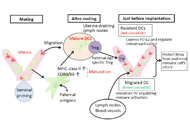 Pregnancy depends on a delicate balance of immune activation and regulationOpen AccessReviewIt is well recognized that immune tolerance is important to prevent semiallografted fetuses from rejection by maternal immunocompetent cells; however, immune activation also plays an important role ...Shigeru Saito ... Sayaka TsudaPublished: December 31, 2021 Explor Immunol. DOI: 10.37349/ei.2021.00031
Pregnancy depends on a delicate balance of immune activation and regulationOpen AccessReviewIt is well recognized that immune tolerance is important to prevent semiallografted fetuses from rejection by maternal immunocompetent cells; however, immune activation also plays an important role ...Shigeru Saito ... Sayaka TsudaPublished: December 31, 2021 Explor Immunol. DOI: 10.37349/ei.2021.00031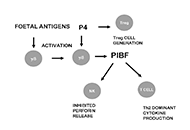 Progesterone induced blocking factor in health and diseaseOpen AccessReviewThe foetus expressing paternal antigens ought to be “rejected” by the maternal immune system. However, the immunological relationship of the mother and the foetus does not follow the rules of transplantation immunology. Maternal immune functions are re-adjusted during pregnancy, to create a tolerant environment for the developing foetus. Progesterone and its downstream mediator; the progesterone induced blocking factor (PIBF) are important in this process. The mRNA transcribed from the PIBF1 gene contains 18 exons, and codes for a 90 kDa protein. The 90 kDa form is associated with the centrosome and plays a role in cell cycle regulation, while smaller isoforms produced by alternative spicing are secreted, and bind to the glycosylphosphatidylinositol (GPI) anchored PIBF receptor. Upon ligation, the former forms a heterodimer with the alpha chain of the interleukin-4 (IL-4) receptor and activates the Janus kinase/signal transducers and activators of transcription (Jak/STAT) pathway, via which, PIBF induces increased production of T helper2 (Th2) cytokines. PIBF regulates natural killer (NK) cytotoxicity, by inhibiting perforin release from the cytoplasmic granules of NK cells. During normal human pregnancy, the serum concentrations of PIBF increase with gestational age, and lower than normal serum levels predict spontaneous pregnancy termination. Depletion of PIBF during the peri-implantation period in mice, results in lower implantation and increased resorption rates, together with increased decidual and peripheral NK activity, downregulation of the genes implicated in T cell activation in CD4+ cells, and Th1 differentiation of the T cells. PIBF is expressed in rapidly proliferating immature cells as well as several tumours, and regulates invasion. The PIBF gene has been identified in the chromosomal region 13q21-q22—which is a common site for somatic deletions in a variety of malignant tumours. These data suggest that PIBF might be involved in tumorigenesis...Julia Szekeres-BarthoPublished: December 31, 2021 Explor Immunol. DOI: 10.37349/ei.2021.00027
Progesterone induced blocking factor in health and diseaseOpen AccessReviewThe foetus expressing paternal antigens ought to be “rejected” by the maternal immune system. However, the immunological relationship of the mother and the foetus does not follow the rules of transplantation immunology. Maternal immune functions are re-adjusted during pregnancy, to create a tolerant environment for the developing foetus. Progesterone and its downstream mediator; the progesterone induced blocking factor (PIBF) are important in this process. The mRNA transcribed from the PIBF1 gene contains 18 exons, and codes for a 90 kDa protein. The 90 kDa form is associated with the centrosome and plays a role in cell cycle regulation, while smaller isoforms produced by alternative spicing are secreted, and bind to the glycosylphosphatidylinositol (GPI) anchored PIBF receptor. Upon ligation, the former forms a heterodimer with the alpha chain of the interleukin-4 (IL-4) receptor and activates the Janus kinase/signal transducers and activators of transcription (Jak/STAT) pathway, via which, PIBF induces increased production of T helper2 (Th2) cytokines. PIBF regulates natural killer (NK) cytotoxicity, by inhibiting perforin release from the cytoplasmic granules of NK cells. During normal human pregnancy, the serum concentrations of PIBF increase with gestational age, and lower than normal serum levels predict spontaneous pregnancy termination. Depletion of PIBF during the peri-implantation period in mice, results in lower implantation and increased resorption rates, together with increased decidual and peripheral NK activity, downregulation of the genes implicated in T cell activation in CD4+ cells, and Th1 differentiation of the T cells. PIBF is expressed in rapidly proliferating immature cells as well as several tumours, and regulates invasion. The PIBF gene has been identified in the chromosomal region 13q21-q22—which is a common site for somatic deletions in a variety of malignant tumours. These data suggest that PIBF might be involved in tumorigenesis...Julia Szekeres-BarthoPublished: December 31, 2021 Explor Immunol. DOI: 10.37349/ei.2021.00027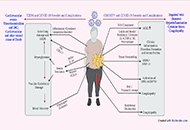 Activation of mucosal immunity and novel prophylactic and therapeutic strategy in combating COVID-19Open AccessReviewCoronavirus disease 2019 (COVID-19) emerges as an expeditiously growing pandemic, in the human population caused by the highly transmissible RNA virus severe acute respiratory syndrome of coronaviru...Swapan K. Chatterjee ... Maria Nilda M. MunozPublished: December 31, 2021 Explor Immunol. DOI: 10.37349/ei.2021.00025
Activation of mucosal immunity and novel prophylactic and therapeutic strategy in combating COVID-19Open AccessReviewCoronavirus disease 2019 (COVID-19) emerges as an expeditiously growing pandemic, in the human population caused by the highly transmissible RNA virus severe acute respiratory syndrome of coronaviru...Swapan K. Chatterjee ... Maria Nilda M. MunozPublished: December 31, 2021 Explor Immunol. DOI: 10.37349/ei.2021.00025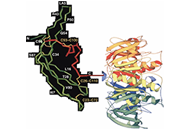 A unique vaccine for birth control and treatment of advanced stage cancers secreting ectopically human chorionic gonadotropinOpen AccessReviewThis article is a tribute and homage to Gerard Chaouat who invited me to contribute this article. My years in France have remained very memorable to me. Reviewed briefly is the vaccine that was made...Gursaran P. Talwar ... Krishna M. EllaPublished: December 31, 2021 Explor Immunol. DOI: 10.37349/ei.2021.00026
A unique vaccine for birth control and treatment of advanced stage cancers secreting ectopically human chorionic gonadotropinOpen AccessReviewThis article is a tribute and homage to Gerard Chaouat who invited me to contribute this article. My years in France have remained very memorable to me. Reviewed briefly is the vaccine that was made...Gursaran P. Talwar ... Krishna M. EllaPublished: December 31, 2021 Explor Immunol. DOI: 10.37349/ei.2021.00026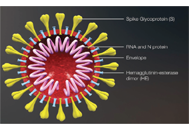 COVID-19 vaccine and immune responseOpen AccessReviewSevere acute respiratory syndrome coronavirus 2 (SARS-CoV-2; βCoV), the causative agent of coronavirus disease 2019 (COVID-19), causes severe lower respiratory tract infections and acute ...Sevilay Hintistan, Hatice DemirağPublished: December 31, 2021 Explor Immunol. DOI: 10.37349/ei.2021.00023
COVID-19 vaccine and immune responseOpen AccessReviewSevere acute respiratory syndrome coronavirus 2 (SARS-CoV-2; βCoV), the causative agent of coronavirus disease 2019 (COVID-19), causes severe lower respiratory tract infections and acute ...Sevilay Hintistan, Hatice DemirağPublished: December 31, 2021 Explor Immunol. DOI: 10.37349/ei.2021.00023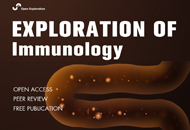 Preeclampsia—an immune disease? An epidemiologic narrativeOpen AccessReviewThe maternal syndrome preeclampsia is triggered by syncytiotrophoblast (STB) stress; the heterogeneity of the syndrome is caused by the different pathways leading to this STB stress. Inflammation pl...Gustaaf Albert Dekker, Pierre Yves RobillardPublished: December 31, 2021 Explor Immunol. DOI: 10.37349/ei.2021.00022
Preeclampsia—an immune disease? An epidemiologic narrativeOpen AccessReviewThe maternal syndrome preeclampsia is triggered by syncytiotrophoblast (STB) stress; the heterogeneity of the syndrome is caused by the different pathways leading to this STB stress. Inflammation pl...Gustaaf Albert Dekker, Pierre Yves RobillardPublished: December 31, 2021 Explor Immunol. DOI: 10.37349/ei.2021.00022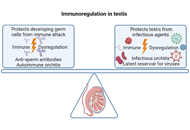 Immunoregulation in the testis and its implication in fertility and infectionsOpen AccessReviewThe testis is designated as one of the immune previleged sites in the body and harbours a unique immunoregulatory environment, which is important for preventing an immune response against sperm anti...Kushaan Khambata ... Satish K. GuptaPublished: December 31, 2021 Explor Immunol. DOI: 10.37349/ei.2021.00021
Immunoregulation in the testis and its implication in fertility and infectionsOpen AccessReviewThe testis is designated as one of the immune previleged sites in the body and harbours a unique immunoregulatory environment, which is important for preventing an immune response against sperm anti...Kushaan Khambata ... Satish K. GuptaPublished: December 31, 2021 Explor Immunol. DOI: 10.37349/ei.2021.00021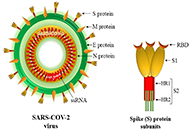 Vaccine-induced immune responses against SARS-CoV-2 infectionsOpen AccessReviewVaccination against coronavirus disease 2019 (COVID-19) is one of the most effective tools to curb the pandemic. Multiple vaccine candidates based on different platforms are available for emergency ...Mandeep Garg ... Suruchi GargPublished: December 31, 2021 Explor Immunol. DOI: 10.37349/ei.2021.00024
Vaccine-induced immune responses against SARS-CoV-2 infectionsOpen AccessReviewVaccination against coronavirus disease 2019 (COVID-19) is one of the most effective tools to curb the pandemic. Multiple vaccine candidates based on different platforms are available for emergency ...Mandeep Garg ... Suruchi GargPublished: December 31, 2021 Explor Immunol. DOI: 10.37349/ei.2021.00024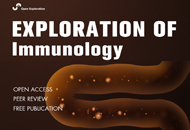 Viral vector-based vaccines against SARS-CoV-2Open AccessReviewViral vectors have been frequently applied for vaccine development. It has also been the case for vaccines against severe acute respiratory syndrome coronavirus 2 (SARS-CoV-2) to tackle the coronavi...Kenneth LundstromPublished: October 31, 2021 Explor Immunol. DOI: 10.37349/ei.2021.00020
Viral vector-based vaccines against SARS-CoV-2Open AccessReviewViral vectors have been frequently applied for vaccine development. It has also been the case for vaccines against severe acute respiratory syndrome coronavirus 2 (SARS-CoV-2) to tackle the coronavi...Kenneth LundstromPublished: October 31, 2021 Explor Immunol. DOI: 10.37349/ei.2021.00020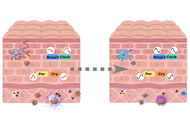 Skin and immune cells crosstalk via circadian regulationsOpen AccessReviewBoth innate and adaptive immune cells exist in the skin, predominantly in the dermis layer. Recent studies have focused on how and which circadian rhythms contribute to maintain good health. Over re...Kanami OriharaPublished: October 31, 2021 Explor Immunol. DOI: 10.37349/ei.2021.00019
Skin and immune cells crosstalk via circadian regulationsOpen AccessReviewBoth innate and adaptive immune cells exist in the skin, predominantly in the dermis layer. Recent studies have focused on how and which circadian rhythms contribute to maintain good health. Over re...Kanami OriharaPublished: October 31, 2021 Explor Immunol. DOI: 10.37349/ei.2021.00019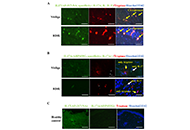 The two faces of mast cells in vitiligo pathogenesisOpen AccessOriginal ArticleAim: Previously, we reported increased number of T helper 17 (Th17) cells in vitiligo. However, in our recent study, tryptase and interleukin (IL)17 double positive cells which identified by polycl...Ichiro Katayama ... Mari Wataya-KanedaPublished: October 31, 2021 Explor Immunol. DOI: 10.37349/ei.2021.00018
The two faces of mast cells in vitiligo pathogenesisOpen AccessOriginal ArticleAim: Previously, we reported increased number of T helper 17 (Th17) cells in vitiligo. However, in our recent study, tryptase and interleukin (IL)17 double positive cells which identified by polycl...Ichiro Katayama ... Mari Wataya-KanedaPublished: October 31, 2021 Explor Immunol. DOI: 10.37349/ei.2021.00018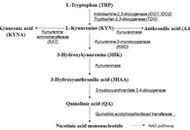 Serum profiles of tryptophan-kynurenine pathway metabolites in psoriasisOpen AccessOriginal ArticleAim: Chronic inflammation is closely associated with tryptophan (TRP)-kynurenine (KYN) metabolic pathway. However, TRP-KYN pathway has not been fully elucidated in psoriasis, a systemic inflammator...Mariko Seishima ... Kuniaki SaitoPublished: October 31, 2021 Explor Immunol. DOI: 10.37349/ei.2021.00017
Serum profiles of tryptophan-kynurenine pathway metabolites in psoriasisOpen AccessOriginal ArticleAim: Chronic inflammation is closely associated with tryptophan (TRP)-kynurenine (KYN) metabolic pathway. However, TRP-KYN pathway has not been fully elucidated in psoriasis, a systemic inflammator...Mariko Seishima ... Kuniaki SaitoPublished: October 31, 2021 Explor Immunol. DOI: 10.37349/ei.2021.00017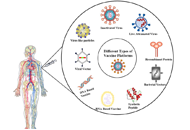 Immune responses induced by different vaccine platforms against coronavirus disease-19Open AccessReviewThere have been significant developments in the design of nanostructured scaffolds for eliciting robust immune responses named vaccine. The technique is to produce strong immune responses is to mani...Eknath D. Ahire, Sanjay J. KshirsagarPublished: October 31, 2021 Explor Immunol. DOI: 10.37349/ei.2021.00016
Immune responses induced by different vaccine platforms against coronavirus disease-19Open AccessReviewThere have been significant developments in the design of nanostructured scaffolds for eliciting robust immune responses named vaccine. The technique is to produce strong immune responses is to mani...Eknath D. Ahire, Sanjay J. KshirsagarPublished: October 31, 2021 Explor Immunol. DOI: 10.37349/ei.2021.00016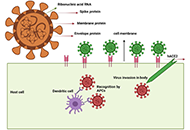 Severe acute respiratory syndrome coronavirus 2 targeted antibodies cocktail and B cell receptor interplay: interventions to trigger vaccine developmentOpen AccessReviewCoronavirus disease-2019 (COVID-19) caused by severe acute respiratory syndrome coronavirus (SARS-CoV)-2 spread globally and creates an alarming situation. Following the SARS-CoV-2 paradigm, therape...Kabeer Haneef ... Zainab FatimaPublished: August 31, 2021 Explor Immunol. DOI: 10.37349/ei.2021.00011
Severe acute respiratory syndrome coronavirus 2 targeted antibodies cocktail and B cell receptor interplay: interventions to trigger vaccine developmentOpen AccessReviewCoronavirus disease-2019 (COVID-19) caused by severe acute respiratory syndrome coronavirus (SARS-CoV)-2 spread globally and creates an alarming situation. Following the SARS-CoV-2 paradigm, therape...Kabeer Haneef ... Zainab FatimaPublished: August 31, 2021 Explor Immunol. DOI: 10.37349/ei.2021.00011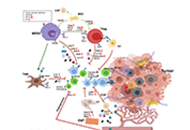 Immunosuppressive microenvironment in oral cancer: implications for cancer immunotherapyOpen AccessReviewHead and neck squamous cell carcinoma (HNSCC) is a relatively widespread cancer with high mortality rates. Many patients with locally advanced disease are treated with combinations of surgery, radia...Shalini K. Sureshbabu ... Shubhada V. ChiplunkarPublished: August 31, 2021 Explor Immunol. DOI: 10.37349/ei.2021.00013
Immunosuppressive microenvironment in oral cancer: implications for cancer immunotherapyOpen AccessReviewHead and neck squamous cell carcinoma (HNSCC) is a relatively widespread cancer with high mortality rates. Many patients with locally advanced disease are treated with combinations of surgery, radia...Shalini K. Sureshbabu ... Shubhada V. ChiplunkarPublished: August 31, 2021 Explor Immunol. DOI: 10.37349/ei.2021.00013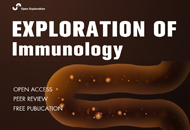 The protective immunity induced by SARS-CoV-2 infection and vaccination: a critical appraisalOpen AccessReviewUnderstanding the interactions of severe acute respiratory syndrome coronavirus-2 (SARS-CoV-2) with humans is deeply grounded in immunology, from the diagnosis to pathogenesis, from the clinical pre...Eduardo TostaPublished: August 31, 2021 Explor Immunol. DOI: 10.37349/ei.2021.00014
The protective immunity induced by SARS-CoV-2 infection and vaccination: a critical appraisalOpen AccessReviewUnderstanding the interactions of severe acute respiratory syndrome coronavirus-2 (SARS-CoV-2) with humans is deeply grounded in immunology, from the diagnosis to pathogenesis, from the clinical pre...Eduardo TostaPublished: August 31, 2021 Explor Immunol. DOI: 10.37349/ei.2021.00014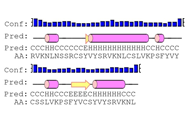 Conserved envelope protein of nCoV2 as the possible target to design polytope vaccineOpen AccessOriginal ArticleAim: The envelope protein of novel coronavirus 2 (nCoV2) was reported to be highly conserved compared to its spike (S) protein which was shown to undergo several alterations in their amino acid seq...Krupanidhi SreeramaPublished: August 31, 2021 Explor Immunol. DOI: 10.37349/ei.2021.00012
Conserved envelope protein of nCoV2 as the possible target to design polytope vaccineOpen AccessOriginal ArticleAim: The envelope protein of novel coronavirus 2 (nCoV2) was reported to be highly conserved compared to its spike (S) protein which was shown to undergo several alterations in their amino acid seq...Krupanidhi SreeramaPublished: August 31, 2021 Explor Immunol. DOI: 10.37349/ei.2021.00012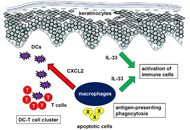 Macrophages and fibroblasts underpin skin immune responsesOpen AccessReviewThere are various types of skin immune responses including inflammatory skin diseases and skin malignancy. Macrophages and fibroblasts are skin resident cells that had been overlooked in terms of im...Makoto SugayaPublished: August 31, 2021 Explor Immunol. DOI: 10.37349/ei.2021.00015
Macrophages and fibroblasts underpin skin immune responsesOpen AccessReviewThere are various types of skin immune responses including inflammatory skin diseases and skin malignancy. Macrophages and fibroblasts are skin resident cells that had been overlooked in terms of im...Makoto SugayaPublished: August 31, 2021 Explor Immunol. DOI: 10.37349/ei.2021.00015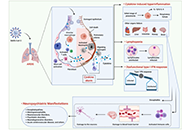 Immunopathogenesis of severe acute respiratory syndrome coronavirus-2: evolving knowledge and its current statusOpen AccessReviewAs the severe acute respiratory syndrome coronavirus (SARS-CoV)-2 is a new virus, the current knowledge on the immunopathogenesis of this newly emerged SARS-CoV-2 is beginning to unravel with intens...Nitin Saksena ... Monica Miranda-SaksenaPublished: June 30, 2021 Explor Immunol. DOI: 10.37349/ei.2021.00007
Immunopathogenesis of severe acute respiratory syndrome coronavirus-2: evolving knowledge and its current statusOpen AccessReviewAs the severe acute respiratory syndrome coronavirus (SARS-CoV)-2 is a new virus, the current knowledge on the immunopathogenesis of this newly emerged SARS-CoV-2 is beginning to unravel with intens...Nitin Saksena ... Monica Miranda-SaksenaPublished: June 30, 2021 Explor Immunol. DOI: 10.37349/ei.2021.00007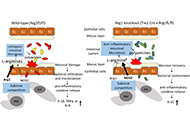 L-arginine as a novel target for clinical intervention in inflammatory bowel diseaseOpen AccessReviewArginase-1 (Arg1) and the inducible nitric oxide synthase 2 (NOS2) compete for the common substrate L-arginine, semi-essential amino acid, and central intestinal metabolite. Both enzymes exhibit var...Björn Nüse, Jochen MattnerPublished: June 30, 2021 Explor Immunol. DOI: 10.37349/ei.2021.00008
L-arginine as a novel target for clinical intervention in inflammatory bowel diseaseOpen AccessReviewArginase-1 (Arg1) and the inducible nitric oxide synthase 2 (NOS2) compete for the common substrate L-arginine, semi-essential amino acid, and central intestinal metabolite. Both enzymes exhibit var...Björn Nüse, Jochen MattnerPublished: June 30, 2021 Explor Immunol. DOI: 10.37349/ei.2021.00008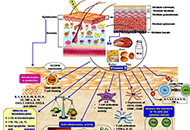 Vitamin D and immunomodulation in the skin: a useful affirmative nexusOpen AccessReviewSkin is the largest organ of the body having multifunctional activities. It has a dynamic cellular network with unique immunologic properties to maintain defensive actions, photoprotection, immune r...Saptadip SamantaPublished: June 30, 2021 Explor Immunol. DOI: 10.37349/ei.2021.00009
Vitamin D and immunomodulation in the skin: a useful affirmative nexusOpen AccessReviewSkin is the largest organ of the body having multifunctional activities. It has a dynamic cellular network with unique immunologic properties to maintain defensive actions, photoprotection, immune r...Saptadip SamantaPublished: June 30, 2021 Explor Immunol. DOI: 10.37349/ei.2021.00009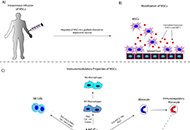 Interplay between mesenchymal stromal cells and immune system: clinical applications in immune-related diseasesOpen AccessReviewMesenchymal stromal cells (MSCs) are a mesodermal stem cell population, with known self-renewal and multilineage differentiation properties. In the last century, MSCs have been widely used in regene...Panagiotis Mallis ... Catherine Stavropoulos GiokasPublished: June 30, 2021 Explor Immunol. DOI: 10.37349/ei.2021.00010
Interplay between mesenchymal stromal cells and immune system: clinical applications in immune-related diseasesOpen AccessReviewMesenchymal stromal cells (MSCs) are a mesodermal stem cell population, with known self-renewal and multilineage differentiation properties. In the last century, MSCs have been widely used in regene...Panagiotis Mallis ... Catherine Stavropoulos GiokasPublished: June 30, 2021 Explor Immunol. DOI: 10.37349/ei.2021.00010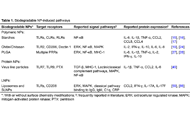 Immunology of biodegradable nanoparticles: a brief overview on a wide growing fieldOpen AccessReviewImmunity is continuously evolving by evolutionary mechanisms shaped by pathogenic stimuli of different kinds. Man-made nanomaterials (NMs) have been developed in the last decades and represent a nov...Anissa Pisani, Giuseppe BardiPublished: April 30, 2021 Explor Immunol. DOI: 10.37349/ei.2021.00006
Immunology of biodegradable nanoparticles: a brief overview on a wide growing fieldOpen AccessReviewImmunity is continuously evolving by evolutionary mechanisms shaped by pathogenic stimuli of different kinds. Man-made nanomaterials (NMs) have been developed in the last decades and represent a nov...Anissa Pisani, Giuseppe BardiPublished: April 30, 2021 Explor Immunol. DOI: 10.37349/ei.2021.00006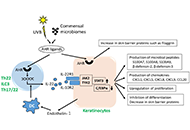 Interleukin-22 and keratinocytes; pathogenic implications in skin inflammationOpen AccessReviewInterleukin (IL)-22 is produced from immune cells such as T helper (Th)22 cells, Th17/22 cells, and group 3 innate lymphoid cells. IL-22 signals via the IL-22 receptor 1 (IL-22R1) and the IL-10 rece...Masutaka Furue, Mihoko FuruePublished: April 30, 2021 Explor Immunol. DOI: 10.37349/ei.2021.00005
Interleukin-22 and keratinocytes; pathogenic implications in skin inflammationOpen AccessReviewInterleukin (IL)-22 is produced from immune cells such as T helper (Th)22 cells, Th17/22 cells, and group 3 innate lymphoid cells. IL-22 signals via the IL-22 receptor 1 (IL-22R1) and the IL-10 rece...Masutaka Furue, Mihoko FuruePublished: April 30, 2021 Explor Immunol. DOI: 10.37349/ei.2021.00005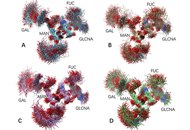 Correlation of N-glycan dynamics and interaction network with allosteric antigen binding and Fc receptor recognitionOpen AccessOriginal ArticleAim: Fragment crystallizable (Fc) glycans modulate Fc conformations and functions, and glycan may also regulate antigen recognition. In the antibody drug development, glycosylation patterns affect a...Buyong MaPublished: April 30, 2021 Explor Immunol. DOI: 10.37349/ei.2021.00004
Correlation of N-glycan dynamics and interaction network with allosteric antigen binding and Fc receptor recognitionOpen AccessOriginal ArticleAim: Fragment crystallizable (Fc) glycans modulate Fc conformations and functions, and glycan may also regulate antigen recognition. In the antibody drug development, glycosylation patterns affect a...Buyong MaPublished: April 30, 2021 Explor Immunol. DOI: 10.37349/ei.2021.00004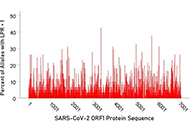 In silico investigation of binding affinities between human leukocyte antigen class I molecules and SARS-CoV-2 virus spike and ORF1ab proteinsOpen AccessOriginal ArticleAim: The novel coronavirus severe acute respiratory syndrome coronavirus 2 (SARS-CoV-2) causes coronavirus disease 2019, a global pandemic. There is hence an urgent need for effective approaches to...Spyros A. Charonis ... Apostolos P. GeorgopoulosPublished: April 30, 2021 Explor Immunol. DOI: 10.37349/ei.2021.00003
In silico investigation of binding affinities between human leukocyte antigen class I molecules and SARS-CoV-2 virus spike and ORF1ab proteinsOpen AccessOriginal ArticleAim: The novel coronavirus severe acute respiratory syndrome coronavirus 2 (SARS-CoV-2) causes coronavirus disease 2019, a global pandemic. There is hence an urgent need for effective approaches to...Spyros A. Charonis ... Apostolos P. GeorgopoulosPublished: April 30, 2021 Explor Immunol. DOI: 10.37349/ei.2021.00003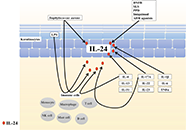 The role of interleukin-24 in atopic dermatitisOpen AccessReviewAtopic dermatitis (AD) is characterized by skin barrier disruption, type 2 immune dysregulation, chronic pruritus, and abnormal colonization by Staphylococcus aureus (S. aureus). Tapinarof, an aryl ...Yen Hai Vu ... Gaku TsujiPublished: April 30, 2021 Explor Immunol. DOI: 10.37349/ei.2021.00002
The role of interleukin-24 in atopic dermatitisOpen AccessReviewAtopic dermatitis (AD) is characterized by skin barrier disruption, type 2 immune dysregulation, chronic pruritus, and abnormal colonization by Staphylococcus aureus (S. aureus). Tapinarof, an aryl ...Yen Hai Vu ... Gaku TsujiPublished: April 30, 2021 Explor Immunol. DOI: 10.37349/ei.2021.00002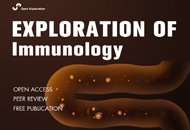 Exploration of Immunology: challenging knowledge, developing curiosity and transforming passion into discoveryOpen AccessEditorialDominique J Charron, Reem Al-DaccakPublished: April 30, 2021 Explor Immunol. DOI: 10.37349/ei.2021.00001
Exploration of Immunology: challenging knowledge, developing curiosity and transforming passion into discoveryOpen AccessEditorialDominique J Charron, Reem Al-DaccakPublished: April 30, 2021 Explor Immunol. DOI: 10.37349/ei.2021.00001 -